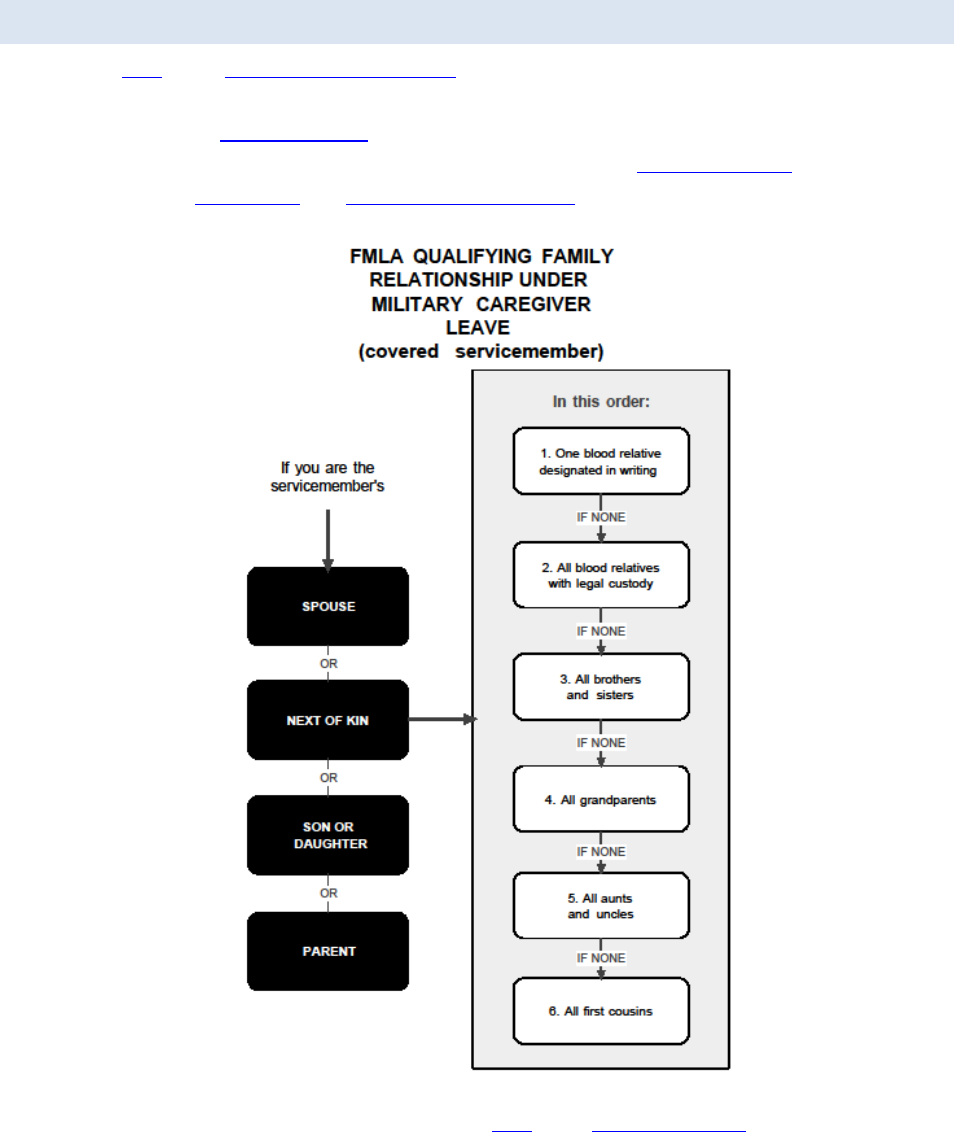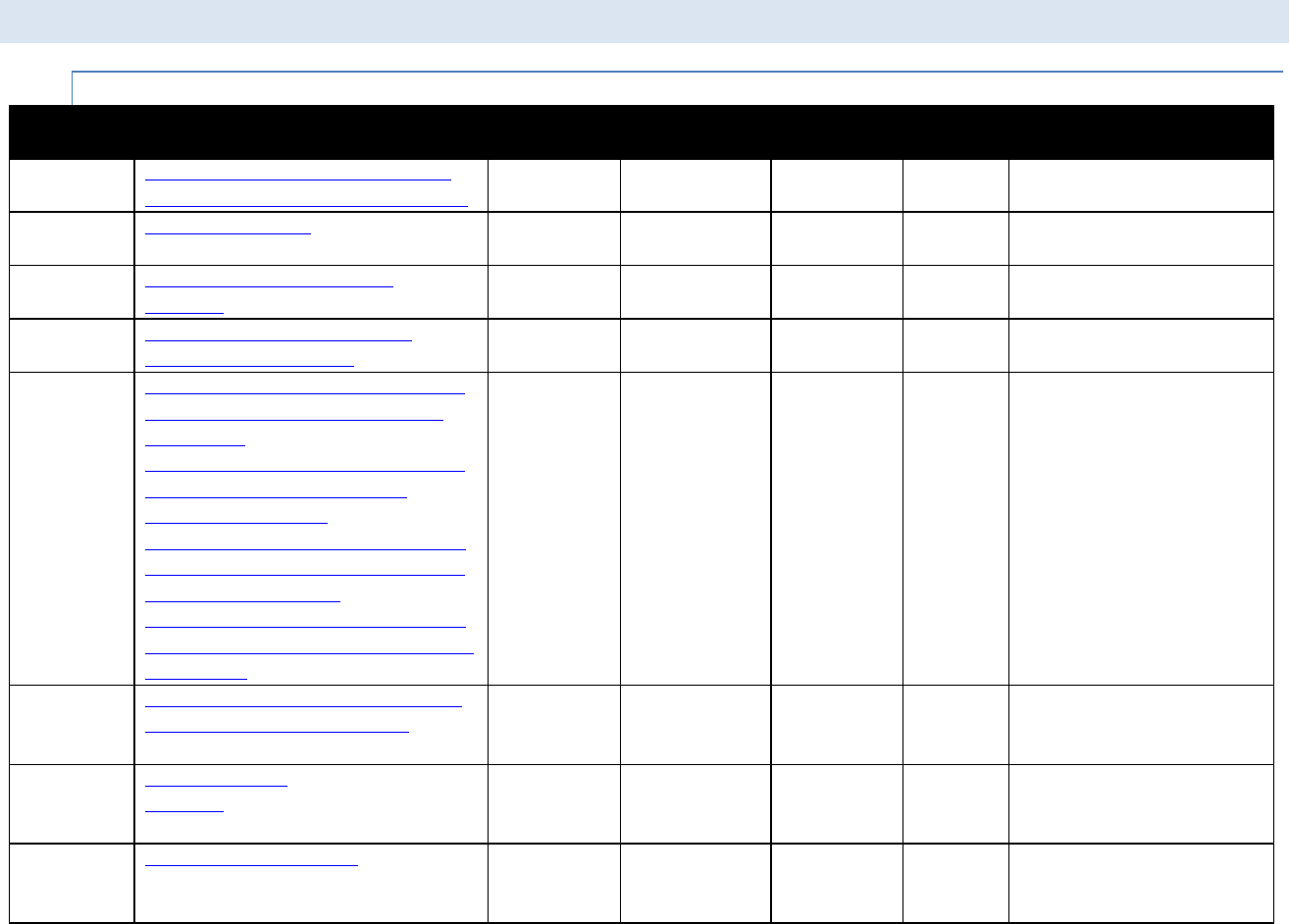
FAMILY AND
MEDICAL
LEAVE
ACT (FMLA)
OVERVIEW
For State of Nevada Executive Branch Agencies
Based on the U.S. Department of Labor’s Final Rule effective March 27, 2015.
September 2023
Page | 2
SUMMARY ................................................................................................................................................. 6
ELIGIBILITY ............................................................................................................................................. 7
QUALIFYING LEAVE EVENTS ............................................................................................................. 9
Basic Leave Entitlements .......................................................................................................................................... 9
Son or Daughter ................................................................................................................................................... 9
Domestic Partner ................................................................................................................................................ 10
Serious Health Condition ................................................................................................................................... 11
Qualifying Exigency Entitlement............................................................................................................................ 12
Military Family Leave Entitlement ......................................................................................................................... 14
Covered Servicemember .................................................................................................................................... 16
Covered Veteran ............................................................................................................................................ 16
Serious Injury or Illness ..................................................................................................................................... 16
ENTITLEMENT PROVISIONS ............................................................................................................. 18
Basic Leave Entitlement ......................................................................................................................................... 18
Qualifying Exigency Entitlement............................................................................................................................ 18
Military Family Leave Entitlement ......................................................................................................................... 18
General .................................................................................................................................................................... 19
Insurance ............................................................................................................................................................ 20
Concurrent Paid Leave ....................................................................................................................................... 21
Intermittent or Reduced Schedule Leave ........................................................................................................... 21
“Light Duty” ...................................................................................................................................................... 23
Alternative Position ............................................................................................................................................ 24
Restoration to Position ....................................................................................................................................... 25
Key Employee ............................................................................................................................................... 25
Retirement .......................................................................................................................................................... 26
Effect of Leave without Pay ............................................................................................................................... 26
Page | 3
Impact of FMLA Leave ..................................................................................................................................... 26
RIGHTS & RESPONSIBILITIES .......................................................................................................... 28
Notice of Need for Leave ........................................................................................................................................ 28
Foreseeable Need ............................................................................................................................................... 29
Unforeseeable Need ........................................................................................................................................... 29
Notice of Intent to Return to Work ......................................................................................................................... 30
Notices .................................................................................................................................................................... 30
Poster.................................................................................................................................................................. 30
Handbook ........................................................................................................................................................... 30
Forms ................................................................................................................................................................. 31
FMLA Leave of Absence Form (NPD-60).................................................................................................... 31
Notice of Eligibility and Rights & Responsibilities (NPD-62) ..................................................................... 31
Certification ................................................................................................................................................... 32
General Rule ............................................................................................................................................. 32
Second & Third Medical Opinions ...................................................................................................... 34
Annual Medical Certification .............................................................................................................. 34
Recertification ...................................................................................................................................... 35
Qualifying Exigency Leave ...................................................................................................................... 35
Military Family Leave .............................................................................................................................. 36
Failure to Provide Certification ................................................................................................................ 36
Designation Form (NPD-63) ......................................................................................................................... 37
Medical Release (NPD-81) ........................................................................................................................... 37
Consequences of Failing to Provide Notice ....................................................................................................... 38
RECORD KEEPING ................................................................................................................................ 40
SPECIAL RULES FOR SCHOOL EMPLOYEES ............................................................................... 44
SPECIAL RULES APPLICABLE TO AIRLINE FLIGHT CREW EMPLOYEES ......................... 45
Page | 4
EFFECT OF OTHER LAWS & BENEFITS ......................................................................................... 46
Discrimination ........................................................................................................................................................ 46
Family Sick Leave .................................................................................................................................................. 46
Nevada Pregnant Workers’ Fairness Act ................................................................................................................ 47
Workers’ Compensation ......................................................................................................................................... 47
Americans with Disabilities Act (ADA) & ADAAA .............................................................................................. 48
Title VII of the Civil Rights Act of 1964 ................................................................................................................ 49
Fair Labor Standards Act (FLSA) ........................................................................................................................... 49
Genetic Information Nondiscrimination Act (GINA) ............................................................................................. 49
Health Insurance Portability and Accountability Act (HIPAA) .............................................................................. 50
Pregnancy Discrimination Act ................................................................................................................................ 50
(federal) Pregnant Workers Fairness Act ................................................................................................................ 51
Uniformed Services Employment and Reemployment Rights Act of 1994 (USERRA) ........................................ 51
PROHIBITED ACTS ............................................................................................................................... 52
APPENDICES ........................................................................................................................................... 54
Appendix A-Tools .................................................................................................................................................. 54
Process & Documentation Checklist .................................................................................................................. 54
Notice Obligations ............................................................................................................................................. 57
Appendix B-Documentation ................................................................................................................................... 58
Sample Letters.................................................................................................................................................... 58
Certification-2nd Opinion ............................................................................................................................. 58
Certification-3rd opinion ............................................................................................................................... 60
Failure to Provide Certification ..................................................................................................................... 61
Intermittent Leave Agency Procedures ......................................................................................................... 62
Medical Certification Clarification (recertification) ...................................................................................... 63
Warning of Leave Expiration (no medical release to return to work) ........................................................... 64
Page | 5
Warning of Leave Expiration (medical release to return to work) ................................................................ 65
Warning of Exceeded Leave (LWOP) .......................................................................................................... 66
Warning of Exceeded Leave ......................................................................................................................... 67
Appendix C-Definitions .......................................................................................................................................... 68

SUMMARY
The Family and Medical Leave Act of 1993 (FMLA) is a federal law. The FMLA was amended
by the National Defense Authorization Act for Fiscal Year 2008, the National Defense
Authorization Act for Fiscal Year 2010 and the Airline Flight Crew Technical Corrections Act.
The federal regulations governing application of the law were last revised effective March 27,
2015. The FMLA is administered and enforced by the Wage and Hour Division of the United
States Department of Labor. The Rules for State Personnel Administration adopt by reference the
federal law and regulations regarding the FMLA. (NAC 284.581)
The FMLA entitles eligible employees to take job-protected leave for specified family and medical
reasons with continuation of group health insurance coverage under the same terms and conditions
as if the employee had not taken leave.
Eligible employees are entitled to:
▪ Up to twelve workweeks of leave in a 12-month period for:
o the birth of a son or daughter and to care for the newborn child within one year of
birth;
o the placement with an employee of a son or daughter for adoption or foster care and
to care for the newly placed child within one year of placement;
o to care for the employee’s spouse, son, daughter, or parent who has a serious health
condition;
o a serious health condition that makes the employee unable to perform the essential
functions of his or her job;
o any qualifying exigency arising out of the fact that the employee’s spouse, son,
daughter, or parent is a military member on covered active duty; or
▪ Up to twenty-six workweeks of leave during a single 12-month period to care for a covered
servicemember (including covered veterans) with a serious injury or illness if the eligible
employee is the servicemember’ s spouse, son, daughter, parent, or next of kin.
The material contained in this overview covers the major provisions of the FMLA as it applies to
State employees. The overview is not a substitute for the Family and Medical Leave Act of 1993
as amended, the associated federal regulations (29 C.F.R. Part 825), or the Rules for State
Personnel Administration (Nevada Revised Statute and Nevada Administrative Code Chapter
284). This guide is not presented as legal counsel and individual circumstances may warrant
involvement of your agency’s legal counsel. The material is current as of the publication date but
is subject to change as laws and regulations are modified.

ELIGIBILITY
An ‘‘eligible employee’’ is an employee who:
▪ Has been employed by the State of Nevada for at least 12 months
1
; and
▪ Has at least 1,250 hours of service in State service during the 12-month period immediately
preceding the first day of the leave.
2
The 12 months an employee must have been employed do not need to be consecutive. However,
employment periods prior to a break in employment with the State of 7 years or more need not be
counted in determining whether the employee has been employed for at least 12 months, unless
the employee has:
▪ Any period(s) of absence from work due to USERRA-covered service (e.g., service in the
National Guard or Reserves) which must be also counted in determining whether the
employee has been employed for at least 12 months
3
; or
▪ A written agreement exists concerning the agency’s intention to rehire the employee after
the break in employment with the agency.
Additionally, an employee with a period of absence from work due to USERRA covered service
(e.g., service in the National Guard or Reserves) in the 12 months preceding the first day of leave
would be credited with the hours of service that would have been performed but for the USERRA
covered service absence.
The determination of whether an employee has at least 1,250 hours of service in the preceding 12
months and has been employed by the State of Nevada for at least 12 months must be made as of
the date the FMLA leave begins.
For purposes of determining whether intermittent/temporary/seasonal/part-time employment
qualifies as ‘‘at least 12 months,’’ 52 weeks are considered equal to 12 months.
1
Based upon the federal regulations (29 C.F.R. § 825.110 (b)(3)), catastrophic leave should be counted when
determining the employee’s 12 months of employment for FMLA eligibility. However, it is not included in the
calculation of the 1,250 hours of service eligibility factor.
2
Federal regulations provide a third eligibility factor that is not generally used in State service, see 29 CFR §
825.110(a).
3
See VII. EFFECT OF OTHER LAWS AND BENEFITS, Uniformed Services Employment and Reemployment
Rights Act of 1994 (USERRA).

ELIGIBILITY
Page | 8
If an employee’s schedule varies from week to week, a weekly average of the hours worked over
the 12 months prior to the beginning of leave would be used for calculating an employee’s normal
workweek.
With regard to exempt (as defined by the Fair Labor Standards Act
4
) employees for whom no
hours worked records are kept, eligibility for FMLA leave must be presumed for any employee
who has been employed for at least 12 months.
4
See VII. EFFECT OF OTHER LAWS AND BENEFITS, Fair Labor Standards Act

QUALIFYING LEAVE EVENTS
If an employee is eligible, what leave events are protected by the FMLA?
BASIC LEAVE ENTITLEMENTS
▪ The birth of a son or daughter and to care for the newborn child.
A portion of the leave could be leave for the serious health condition of the mother. The
mother would be eligible to use sick leave while she is physically incapacitated due to
childbirth (i.e., until released from doctor's care). Also, a parent would be eligible to use
sick leave if caring for a child with a serious health condition. Entitlement to leave based
on birth expires 12 months after the child's date of birth. If spouses are both employed by
the State of Nevada, they are together entitled to only a total of 12 workweeks of leave for
bonding time with an infant that does not meet the definition of a serious health condition.
Leave for the serious health condition of the mother or the child is not subject to the
combined limit.
▪ The placement with the employee of a son or daughter for adoption or foster care.
Entitlement to leave expires 12 months after the date of placement of the child with the
employee. FMLA leave can begin before the actual placement for adoption or foster care
if an absence from work is required for the placement to proceed (e.g., counseling sessions,
consultation with attorney, court appearance). If spouses are both employed by the State
of Nevada, the adoptive or foster parents together are entitled to only a total of 12
workweeks of leave.
▪ To care for the employee’s spouse, son, daughter or parent with a serious health condition.
FMLA leave is not available to care for a sibling or parent-in-law under this provision.
▪ A serious health condition that makes the employee unable to perform the functions of his
or her essential functions.
SON OR DAUGHTER
“Son or daughter” (for leave taken for birth or adoption or to care for a family member with a
serious health condition) means a biological, adopted, or foster child, a stepchild, a legal ward, or
a child of a person standing in loco parentis, who is either under age 18, or age 18 or older and
‘‘incapable of self-care because of a mental or physical disability’’ at the time that FMLA leave
begins.

QUALIFYING LEAVE EVENTS
Page | 10
“Incapable of self-care” means that the son or daughter requires active assistance or supervision
to provide daily self-care in three or more of the activities of daily living (ADLs) or instrumental
activities of daily living (IADLs). Activities of daily living include adaptive activities such as
caring appropriately for one’s grooming and hygiene, bathing, dressing and eating. Instrumental
activities of daily living include cooking, cleaning, shopping, taking public transportation, paying
bills, maintaining a residence, using telephones and directories, using a post office, etc.
A physical or mental disability means a physical or mental impairment that substantially limits
one or more of the major life activities of an individual as defined by the Americans with
Disabilities Act (ADA).
5
Individuals who are ‘‘in loco parentis’’ include those with day-to-day responsibilities to care for
or financially support a child, or, in the case of an employee, who had such responsibility for the
employee when the employee was a child. A biological or legal relationship is not necessary.
DOMESTIC PARTNER
NRS 122A codifies domestic partnerships as a type of civil contract recognized in the State of
Nevada. The State of Nevada Attorney General, in an opinion dated April 12, 2010, stated that
“S.B. 283 requires the State to afford the same rights to an employee with a domestic partner as
are provided for a spouse under the FMLA”. To be afforded the same rights as a spouse, an
employee must be part of a domestic partnership recognized by a state (e.g., Nevada, California)
or other jurisdiction.
In the FMLA Final Rule Summary of Comments published February 25, 2015, the Department of
Labor states:
“A number of the comments received addressed issues that are statutory and therefore beyond the
scope or authority of the proposed regulations, such as expanding the coverage of the Act to
include domestic partners and parents in law. Because addressing these issues would require
statutory changes, these comments are not addressed in this Final Rule. Moreover, the Department
has previously issued guidance on some of these issues. See, e.g., Opinion Letter FMLA-98 (Nov.
18, 1998) (the FMLA does not cover absences to care for a domestic partner with a serious health
condition)
1
…
1
As noted above, the portion of Opinion Letter FMLA-98 that relied on DOMA's
definition of spouse and marriage is now invalid in light of Windsor. The remaining portion of
Opinion Letter FMLA-98, however, continues to be valid. Specifically, the opinion letter noted
that the FMLA's legislative history indicated that the definition of spouse was meant to ensure that
employers would not be required to provide leave to care for an employee's domestic partner.”
Due to the conflict between federal and State law, it is recommended, that when dealing with an
otherwise qualifying FMLA leave event involving a domestic partnership, an agency consult with
5
See VII. EFFECT OF OTHER LAWS AND BENEFITS, Americans with Disabilities Act (ADA) & ADAAA.

QUALIFYING LEAVE EVENTS
Page | 11
its’ legal counsel prior to issuing the Designation Form (NPD-63), see Designation Form (NPD-
63).
SERIOUS HEALTH CONDITION
A serious health condition is an illness, injury, impairment or physical or mental condition that
involves either inpatient care or one of the types of continuing treatment:
▪ In patient care: Overnight stay in a hospital, hospice, or residential medical care facility,
including any period of incapacity, or any connected subsequent treatment.
▪ Continuing treatment:
o Incapacity and treatment: A period of incapacity of more than 3 consecutive, full
calendar days, and any subsequent treatment or period of related incapacity, that
also involves:
▪ Treatment two or more times, within 30 days of the first day of incapacity,
unless extenuating circumstances exist, by a health care provider, by a nurse
under direct supervision of a health care provider, or by a provider of health
care services (e.g., physical therapist) under orders of, or on referral by, a
health care provider; or
▪ Treatment by a health care provider
on at least one occasion, which results
in a regimen of continuing treatment under the supervision of the health care
provider.
The first in-person treatment visit must take place within 7 days of the first day of
incapacity. The health care provider shall determine whether additional treatment
visits or a regimen of continuing treatment is necessary within the 30-day period.
o Pregnancy and prenatal care: Any period of incapacity
due to pregnancy or for
prenatal care.
o Permanent or long-term conditions: A period of incapacity
that is permanent or
long-term due to a condition for which treatment may not be effective. The
employee or family member must be under the continuing (but not necessarily
active) supervision of a health care provider (e.g., Alzheimer’s, a severe stroke,
terminal stages of a disease).
o Conditions requiring multiple treatments: Any period of absence to receive
multiple treatments (including any period of recovery) by a health care provider or

QUALIFYING LEAVE EVENTS
Page | 12
by a provider of health care services under orders of, or on referral by, a health care
provider, for:
▪ Restorative surgery after an accident or other injury; or
▪ A condition that would likely result in a period of incapacity of more than
3 consecutive full calendar days in the absence of medical intervention or
treatment (e.g., chemotherapy, radiation, dialysis).
Absences attributable to incapacity qualify for FMLA leave even though the
employee or the covered family member does not receive treatment from a health
care provider during the absence, and even if the absence does not last more than 3
consecutive full calendar days.
For example, an employee with asthma may be unable to report for work due to the
onset of an asthma attack or because the employee’s health care provider
has
advised the employee to stay home when the pollen count exceeds a certain level.
Also, an employee who is pregnant may be unable to report to work because of
severe morning sickness.
o Chronic condition: Any period of incapacity or treatment for such incapacity due
to a chronic serious health condition, one which:
▪ Requires at least two visits per year for treatment by a health care provider,
or by a nurse under direct supervision of a health care provider;
▪ Continues over an extended period of time (including recurring episodes of
a single underlying condition); and
▪ May cause episodic rather than a continuing period of incapacity (e.g.,
asthma, diabetes, epilepsy).
QUALIFYING EXIGENCY ENTITLEMENT
Any qualifying need to address issues arising out of the fact that the employee’s spouse, son or
daughter (biological, adopted, or foster child, a stepchild, a legal ward, or a child of a person
standing in loco parentis regardless of age), or parent is a military member on covered active duty
or a call to covered active duty status (or has been notified of an impending call or order to active
duty). Covered active duty (or call to active duty status) in the case of regular Armed Forces means
duty during a deployment to a foreign country; and in the case of a member of the Reserves
(including National Guard) means duty during a deployment to a foreign country in support of a
contingency operation.

QUALIFYING LEAVE EVENTS
Page | 13
Qualifying exigencies:
▪ Short-notice deployment. To address any issue that arises from the fact that a military
member is notified of an impending call or order to active duty, 7 calendar days or less
prior to the date of deployment. Under this provision, leave can be used for a period of
seven calendar days beginning on the date the military member is notified of the impending
call or order to active duty.
▪ Military events and related activities. To attend any official ceremony, program, or event
sponsored by the military that is related to the active duty or call to active duty status. To
attend family support or assistance programs and informational briefings sponsored or
promoted by the military, military service organizations, or the American Red Cross that
are related to the active duty or call to active duty status.
▪ Childcare and school activities for a military member’s child (biological, adopted, or foster
child, stepchild, legal ward, or child for whom the military member stands in loco parentis,
who is either under 18 years of age or 18 years of age or older and incapable of self-care
because of a mental or physical disability).
o To arrange for alternative childcare when the active duty or call to active duty
requires a change in the existing childcare arrangements;
o To provide childcare on an urgent, immediate need basis, but not on a routine
everyday basis;
o To enroll in or transfer to a new school or daycare facility; or
o To attend meetings with staff at a school or daycare facility.
▪ Parental care. For leave when the parent (biological, adoptive, step, or foster father or
mother, or any other individual who stood in loco parentis to the military member when
the member was under 18 years of age) of the military member requires active assistance
or supervision to provide daily self-care in three or more of the activities of daily living or
instrumental activities of daily living due to the active duty or call to active duty.
o To arrange for alternative care when the active duty or call to active duty requires
a change in the existing care arrangements;
o To provide care on an urgent, immediate need basis, but not on a routine everyday
basis;
o To admit or transfer to a care facility; or

QUALIFYING LEAVE EVENTS
Page | 14
o To attend meetings with staff at a care facility; but not for routine or regular
meetings.
▪ Financial and legal arrangements.
o Make or update financial or legal arrangements (e.g. powers of attorney);
o Transfer bank account signature authority;
o Enroll in the Defense Enrollment Eligibility Reporting System;
o Obtain military identification cards;
o Prepare or update a will or living trust; or
o Act as the military member’s representative before a federal, state or local agency
to obtain, arrange, or appeal military service benefits while the covered military
member is on active duty or call to active duty status and for a period of 90 days
following the termination of the military member’s
active duty status.
▪ Counseling. To attend counseling provided by someone other than a health care provider
(e.g., chaplain) for oneself, the military member, or for a military member’s child, provided
the need arises from the active duty or call to active duty status.
▪ Rest and recuperation. To spend time with a military member who is on short-term,
temporary, rest and recuperation leave during the period of deployment for up to 15
calendar days for each instance of rest and recuperation.
▪ Post-deployment activities. To attend arrival ceremonies, reintegration briefings and
events, and any other official ceremony or program sponsored by the military for a period
of 90 days following the termination of the military member’s active duty status. To
address issues that arise from the death of a military member while on active duty status,
such as meeting and recovering the body of the military member and making funeral
arrangements.
▪ Additional activities. To address other events that arise out of the military member’s active
duty or call to active duty status provided that both the employee and agency agree it
qualifies as a qualifying exigency.
MILITARY FAMILY LEAVE ENTITLEMENT
The military family leave entitlement covers a need to care for a covered servicemember.

QUALIFYING LEAVE EVENTS
Page | 15
In order to care for a covered servicemember, an eligible employee must be the spouse, son or
daughter (biological, adopted, or foster child, stepchild, legal ward or a child for whom the covered
servicemember stood in loco parentis and who is of any age), or parent (biological, adoptive, step
or foster father or mother, or any other individual who stood in loco parentis to the covered
servicemember) or next of kin
of a covered servicemember.
An eligible employee must begin taking leave to care for a covered veteran within five years of
the veteran’s active duty service, but the single 12-month period may extend beyond the five-year
period.

QUALIFYING LEAVE EVENTS
Page | 16
COVERED SERVICEMEMBER
A covered servicemember is defined as a:
▪ Member of the Armed Forces (including a member of the National Guard or Reserves)
who is undergoing medical treatment, recuperation, or therapy, is otherwise in outpatient
status, or is otherwise on the temporary disability retired list for a serious injury or illness;
or
▪ Covered veteran who is undergoing medical treatment, recuperation or therapy for a serious
injury or illness.
COVERED VETERAN
A covered veteran is an individual who was a member of the Armed Forces (including a member
of the National Guard or Reserves), and was discharged or released under conditions other than
dishonorable at any time during the five-year period prior to the first date the eligible employee
takes FMLA leave to care for the covered veteran. Per federal regulation, for an individual who
was a member of the Armed Forces (including a member of the National Guard or Reserves) and
who was discharged or released under conditions other than dishonorable prior to March 8, 2013,
the period between October 28, 2009 and March 8, 2013 shall not count towards the determination
of the five year period for covered veteran status.
SERIOUS INJURY OR ILLNESS
Serious injury or illness of a covered servicemember:
▪ Current member of the Armed Forces, including a member of the National Guard or
Reserves - an injury or illness that was incurred by the covered servicemember in the line
of duty on active duty in the Armed Forces or that existed before the beginning of the
member’s active duty and was aggravated by service in the line of duty on active duty in
the Armed Forces and that may render the servicemember medically unfit to perform the
duties of the member’s office, grade, rank, or rating; and
▪ Covered veteran - an injury or illness that was incurred by the member in the line of duty
on active duty in the Armed Forces (or existed before the beginning of the member’s active
duty and was aggravated by service in the line of duty on active duty in the Armed Forces)
and manifested itself before or after the member became a veteran, and is:
o A continuation of a serious injury or illness that was incurred or aggravated when
the covered veteran was a member of the Armed Forces and rendered the
servicemember unable to perform the duties of the servicemember’ s office, grade,
rank, or rating; or

QUALIFYING LEAVE EVENTS
Page | 17
o A physical or mental condition for which the covered veteran has received a U.S.
Department of Veterans Affairs Service-Related Disability Rating (VASRD) of 50
percent or greater, and such VASRD rating is based, in whole or in part, on the
condition precipitating the need for military caregiver leave; or
o A physical or mental condition that substantially impairs the covered veteran’s
ability to secure or follow a substantially gainful occupation by reason of a
disability or disabilities related to military service, or would do so absent treatment;
or
o An injury, including a psychological injury, on the basis of which the covered
veteran has been enrolled in the Department of Veterans Affairs Program of
Comprehensive Assistance for Family Caregivers.

ENTITLEMENT PROVISIONS
BASIC LEAVE ENTITLEMENT
Basic leave entitlements allow for up to 12 workweeks of leave during a “rolling” 12-month period
measured backward from the date an employee first uses qualifying FMLA leave.
QUALIFYING EXIGENCY ENTITLEMENT
Qualifying exigency leave entitlements allow for up to 12 workweeks of leave, with the exception
of the below restrictions, during a “rolling” 12-month period measured backward from the date an
employee first uses qualifying FMLA leave.
However, two types of exigencies have shorter entitlement periods:
▪ Short-notice deployment-Leave taken for this purpose can be used for a period of 7
calendar days beginning on the date a covered military member is notified of an impending
call or order to active duty.
▪ Rest and recuperation-Leave taken for this purpose can be used for a period of up to 15
days of leave for each instance.
MILITARY FAMILY LEAVE ENTITLEMENT
Military family leave entitlement allows up to 26 workweeks of leave to care for a covered
servicemember during a single 12-month period. The single 12-month period begins on the first
day the eligible employee takes FMLA leave to care for a covered servicemember and ends 12
months after that date, regardless of the rolling 12-month period that determines the employee’s
12 workweeks of leave entitlement for other FMLA-qualifying reasons.
This leave entitlement is to be applied on a per-covered-servicemember, per-injury basis. For that
reason, an eligible employee may be entitled to take more than one period of 26 workweeks of
leave if the leave is to care for different covered servicemembers or to care for the same covered
servicemember with a subsequent serious injury or illness. However, no more than 26 workweeks
of leave may be taken within any single 12-month period.
If an eligible employee has another approved FMLA-qualifying leave event during that single 12-
month period, an eligible employee may split the 26 workweeks of leave between military family
leave entitlement and that other approved FMLA-qualifying leave event(s). However, use of
FMLA leave for other reasons may not exceed more than the entitled period (generally 12 weeks)
regardless of whether the military family leave uses fewer than 14 weeks. For example, an eligible
employee may during the “single 12 month period”, use 16 weeks of FMLA leave to care for a
covered servicemember and 10 weeks of FMLA leave to care for a newborn son or daughter.

ENTITLEMENT PROVISIONS
Page | 19
However, the employee may not use more than 12 weeks of FMLA leave to care for the newborn
child during the “single 12 month period” even if the employee takes fewer than 14 weeks of
FMLA leave to care for the covered servicemember.
Spouses who are both employed by the State, are limited in the amount of FMLA leave they may
take for the birth and care of a newborn son or daughter, placement of a son or daughter for
adoption or foster care, or to care for their own parent who has a serious health condition to a joint
total of 12 weeks or a joint total of 26 weeks if leave to care for a covered servicemember with a
serious injury or illness is also used.
For example, if an employee took 6 weeks of FMLA leave to care for his or her parent and his or
her spouse (who also works for the State of Nevada) took 6 weeks of FMLA leave to care for his
or her parent within the same “rolling” 12-month period that would zero out their combined 12
weeks. Neither would be able to take any FMLA leave to care
for a son or daughter after birth
(bonding), for placement for adoption or foster care or to care for their own parent with a serious
health condition within that period. They could take FMLA leave for other FMLA qualifying
events (e.g., employee’s own serious health condition, serious health condition of a son or
daughter). However, they could only take up to the remainder of their own maximum
entitlement (6 or 20 weeks).
GENERAL
The FMLA does not require an agency to provide paid leave in any situation in which it would not
normally provide paid leave. Unless an employee elects otherwise, at the end of FMLA leave,
benefits must be resumed in the same manner and at the same levels as provided when leave began.
However, the benefits will be subject to any changes in benefit levels that affected the entire
workforce. Benefits include benefits provided or made available to employees by the State,
including group life insurance, health insurance, disability insurance, sick leave, annual leave,
educational benefits, and retirement, regardless of whether such benefits are provided by a practice
or written policy of the State through an employee benefit plan. In addition, an employee cannot
be required to requalify for any benefits the employee had before his or her FMLA leave began.
Coverage under the FMLA must be granted equally to both men and women, including the
caregiving provisions. Providing fair and equal treatment to employees on FMLA leave can
include the following:
▪ Providing equal access to training opportunities;
▪ Providing equal opportunity to participate on complex or high-profile work assignments
that will enhance an employee’s skills and experience.

ENTITLEMENT PROVISIONS
Page | 20
INSURANCE
During FMLA leave an agency must maintain an employee’s group health coverage on the same
conditions as the coverage would have been provided if the employee had been continuously
employed during the leave period. An employee on FMLA (paid or unpaid) leave, who has met
the eligibility requirements to enroll in coverage by the Public Employees’ Benefits Program
(PEBP) and enrolls for coverage, will remain eligible for coverage while on FMLA (paid or
unpaid) leave. The employing agency must continue to pay the monthly employer contribution
for an employee who continues coverage while on FMLA leave. If coverage is terminated because
of the employee’s non-payment, the agency's responsibility for paying the monthly employer
contribution for the employee will cease.
The employing agency shall notify PEBP within 15 days of an employee’s start of unpaid FMLA
leave; notification must be completed through the submission of a Benefit Change Form. The
agency must also notify PEBP through the submission of a Benefits Change Form within 15 days
of an employee’s return to paid status.
An employee who has exhausted his or her FMLA leave entitlement and is approved for leave
without pay (LWOP) must be placed in PEBP’s definition of leave without pay based upon the
following criteria. PEBP defines leave without pay as beginning when an agency determines that
an employee’s hours in a given month are fewer than 80. The agency must include hours actually
worked, sick leave, annual leave, compensatory time, catastrophic leave and FMLA when
determining whether an employee has worked fewer than 80 hours in a given month. An agency
must notify PEBP through the submission of a Benefits Change Form within 15 days of an
employee’s start of leave without pay as defined by PEBP (see above).
At the start of FMLA leave, an employee shall have the option to modify (or decline) coverage.
To modify coverage, the employee must submit a Benefit Enrollment and Change Form to PEBP
within 60 days of the beginning of FMLA leave.
Upon returning from leave, the employee shall have the option to modify coverage through the
submission of a Benefit Enrollment and Change Form to PEBP within 60 days of his or her return
from FMLA leave, regardless of termination of coverage due to non-payment. If the employee
does not submit a Benefit Enrollment and Change Form within 60 days, coverage will be reinstated
to the same plan and coverage as the employee had before the start of FMLA leave, unless a new
plan year began while the employee was on FMLA leave and the employee selected different
coverage during open enrollment.
The employee shall pay his or her portion of the premium cost due for coverage while on paid or
unpaid FMLA leave. When possible, the premium for such coverage shall be made to PEBP
through payroll deductions; otherwise, PEBP shall bill the employee for the premium amount due.

ENTITLEMENT PROVISIONS
Page | 21
Payment for the current month’s premium shall be due on the 20
th
of each month. An employee
has a 30-day grace period in which to make the premium payment. A past due notice will be
mailed by PEBP to an employee if an employee does not make his or her premium payment when
due. The past due notice shall be mailed at least 15 days before coverage is to cease and will state
the specified date that the coverage will cease. If payment is not received, an employee’s coverage
shall be subject to retroactive termination.
Employees who want to maintain coverage under an optional insurance plan (e.g., voluntary
supplemental life insurance, long-term care insurance) during unpaid FMLA leave will need to
contact the carrier for payment options while on unpaid FMLA leave. An agency will not pay
these premiums on the employee's behalf.
For questions regarding premium payment procedures, contact PEBP at (775) 684-7000 or (800)
326-5496.
CONCURRENT PAID LEAVE
An employee must exhaust all applicable paid leave (e.g., sick leave, compensatory time, annual
leave) before using unpaid leave. (NAC 284.5811) Accrued annual leave may be used for a
FMLA-qualifying purpose when an employee meets the eligibility requirements for annual leave.
State regulations relating to the use of paid leave generally apply unless State requirements are
more stringent than federal FMLA requirements.
A workers’ compensation absence and an employee’s FMLA leave entitlement will run
concurrently when the employee’s on the job injury or occupational illness meets the definition of
a serious health condition as defined by the FMLA. An employee who is receiving benefits for a
temporary total disability may elect to use sick or annual leave, compensatory time and
catastrophic leave if granted, to supplement temporary total disability benefits while on FMLA
leave.
For an injury or illness not related to workers’ compensation, an employee is not required to
exhaust his or her accrued paid leave (i.e., sick, annual, compensatory, catastrophic) if receiving a
benefit (i.e., payment) from a disability benefit plan (e.g., short or long term disability insurance)
while on FMLA covered leave. However, an employee and his or her agency may jointly agree to
allow an employee to use his or her accrued paid leave while receiving a benefit from a disability
plan while on FMLA covered leave.
INTERMITTENT OR REDUCED SCHEDULE LEAVE
Under certain circumstances, FMLA leave may be taken intermittently or on a reduced leave
schedule. Intermittent leave is leave taken in separate blocks of time due to a single reason rather

ENTITLEMENT PROVISIONS
Page | 22
than for one continuous period of time (e.g., medical appointments, several days at a time for
chemotherapy treatments over a period of months). A reduced leave schedule is a leave schedule
that reduces an employee’s usual number of working hours per workweek, or hours per workday.
It is a change in an employee's schedule for a period of time, normally from full-time to part-time
(e.g., an employee works part-time because he or she is recovering from a serious health condition
and is not capable of working full-time). It would not change the position, if full-time, to part-
time; instead, it would be a temporary reduction in hours worked.
An employee cannot be required to take more FMLA leave than necessary. If an employee takes
leave on an intermittent or reduced leave schedule, only the amount of leave actually taken counts
towards the leave entitlement. Where it is physically impossible for an employee requesting
intermittent leave or a reduced leave schedule to begin or end work mid-way through a shift, the
entire period that the employee is forced to be absent is designated as FMLA leave and counts
against the employee’s FMLA entitlement. However when it is physically impossible for an
employee requesting intermittent or reduced schedule leave to begin or end mid-way through a
shift, an attempt should be made to find a temporary alternative position for the employee during
the requested intermittent or reduced leave schedule FMLA leave, see Alternative Position.
If an employee's normal workweek is more or less than 40 hours, the prorated amount of leave
entitlement should be based on the number of hours that constitute an employee’s normal
workweek. If an employee's schedule varies from week to week, a weekly average of the hours
worked over the 12-month period prior to the beginning of the leave would be used for calculating
an employee's normal workweek. If overtime is mandatory for an employee’s position, the
overtime should be included in the 12-month average calculation.
When converting a workweek into hours for an intermittent entitlement for an exempt employee,
as defined under the Fair Labor Standards Act
6
, a standard 40-hour workweek should not
necessarily be assumed. When an exempt employee requests intermittent or reduced schedule
leave, the agency must enter into a written agreement on the normal schedule or average number
of hours worked each week. Because an exempt employee may work in excess of 40 hours a week,
it may be necessary to calculate his or her entitlement based on actual hours worked.
Leave may be taken intermittently or on a reduced leave schedule when there is a medical need,
which is best accommodated through an intermittent or reduced leave schedule (e.g., medical
treatment, recovery from a serious health condition), for the following:
▪ To care for a spouse, son, daughter or parent with a serious health condition;
6
See VII. EFFECT OF OTHER LAWS AND BENEFITS, Fair Labor Standards Act

ENTITLEMENT PROVISIONS
Page | 23
▪ An employee's own serious health condition; or
▪ To care for a covered servicemember or covered veteran with a serious injury or illness.
Intermittent leave or reduced schedule leave may also be taken to provide care or psychological
comfort to a spouse, son, daughter or parent with a serious health condition or a covered
servicemember or covered veteran with a serious injury or illness. In a situation where the
employee or covered family member is incapacitated or unable to perform the essential functions
of the position due to a chronic serious health condition or a serious injury or illness
of a covered
servicemember intermittent or reduced schedule leave may be taken, even if he or she does not
receive treatment by a health care provider.
Leave taken after the birth of a son or daughter or placement of a son or daughter for adoption or
foster care may only be taken intermittently or on a reduced leave schedule if the agency agrees
(i.e., the employee with the agency's agreement works part-time after the birth of a child). The
agency's agreement is not required if the leave is medically necessary due to the employee's or
newborn child's serious health condition.
Employees needing intermittent leave or leave on a reduced schedule are expected to consult with
the agency to work out a schedule, subject to the approval of the health care provider, which does
not unduly disrupt the agency's operations. If the employee neglects to consult with the agency to
make an attempt to arrange a suitable treatment schedule when planning medical treatment, the
agency may initiate the discussion and require the employee to attempt to make such arrangements
(subject to approval of the health care provider).
“LIGHT DUTY”
An employee on FMLA qualifying leave can be offered light duty; however, the employee cannot
be required or coerced to take the light duty. An offer and acceptance of light duty should be
documented in writing prior to the employee coming back to accept the light duty assignment. If
an employee accepts a light duty assignment, the time worked on the light duty assignment would
not be counted against the employee’s FMLA leave entitlement.
When an employee who is eligible for FMLA leave voluntarily accepts light duty, his or her right
to reinstatement (under the FMLA) in the same or an equivalent position remains in place unless
and until the employee cannot resume the original or an equivalent position at the end of the rolling
12-month FMLA period. If the light duty assignment is for a limited period or is ended and the
employee is not able to return to the same or an equivalent position, the employee may use the
remainder of his or her FMLA leave.

ENTITLEMENT PROVISIONS
Page | 24
If the FMLA qualifying event involves a workers’ compensation claim, other requirements may
apply
7
.
If the employee’s limitations meet the standard of disability in the Americans with Disabilities
Act
8
, the ADA interactive process should be started. Your agency’s ADA coordinator (human
resources) should be contacted for more information on the interactive process.
ALTERNATIVE POSITION
An agency may require the employee to transfer temporarily to an available alternative position,
for which the employee is qualified and which better accommodates recurring periods of leave
than the employee's regular position, if:
▪ An employee requests intermittent leave or leave on a reduced leave schedule that is
foreseeable based on planned medical treatment for the employee, a covered family
member or a covered servicemember, including during a period of recovery;
▪ An employee’s position makes it physically impossible for the employee to begin or end
work mid-way through a shift; or
▪ The agency permits the employee to take leave intermittently or on a reduced leave
schedule after the birth of a son or daughter or placement of a son or daughter for adoption
or foster care.
Transfer to an alternative position may include altering an existing position to better accommodate
the employee's need for intermittent or reduced leave. State personnel regulations regarding
transfers to a position in the same or related class also apply including the requirement that an
appointing authority provide an employee with 5 working days' notice before making a transfer
which will exceed 10 working days (NAC 284.394).
The alternative position to which an employee is transferred must have equivalent pay, benefits
and status. An agency may transfer an employee to a part-time job with the same hourly rate of
pay and benefits, provided the employee is not required to take more leave than is necessary. An
agency may not eliminate benefits, which would otherwise not be provided to part-time employees.
However, benefits, such as annual and sick leave, which are normally based on the number of
hours worked or in paid leave status would be prorated accordingly.
7
See VII. EFFECT OF OTHER LAWS AND BENEFITS, Workers’ Compensation
8
See VII. EFFECT OF OTHER LAWS AND BENEFITS, Americans with Disabilities Act (ADA) & ADAAA

ENTITLEMENT PROVISIONS
Page | 25
An agency may not transfer an employee to an alternative position to discourage an employee from
taking FMLA leave or to cause a hardship to the employee (e.g., reassignment from the day shift
to the graveyard shift).
An employee who has been transferred to an alternative position must be placed in the same job
or a job that is equivalent (virtually identical) to the one the employee left when he or she no longer
needs to continue on FMLA leave.
RESTORATION TO POSITION
On return from FMLA leave, an employee is entitled to be returned to the same position he or she
held when leave commenced, or to an equivalent position with equivalent benefits, pay, and other
terms and conditions of employment, including privileges and status. An equivalent position must
involve the same or substantially similar duties and responsibilities, which must involve
substantially equivalent skill, effort, responsibility, and authority. An employee is ordinarily
entitled to return to the same shift or to the same or an equivalent work schedule and to the same
or geographically nearby worksite. An employee is entitled to restoration even if he or she has
been replaced or the employee's position has been restructured to accommodate the absence. The
FMLA does not prohibit an employer from accommodating an employee’s uncoerced request to
be restored to a different shift, schedule, or position that better suits the employee’s personal needs
on return from leave.
If an employee, as a result of FMLA leave, is no longer qualified for the position because of the
inability to meet the requirements of the position (e.g., license, required courses, certification,
flying a minimum number of hours), the employee must be given a reasonable opportunity to fulfill
those conditions upon return to work.
An employee is entitled to any unconditional pay increases that may have occurred during the
FMLA leave period, such as cost of living increases. Pay increases conditioned upon seniority,
length of service, or work performed must be granted in accordance with the State and agency’s
policy or practice with respect to other employees on an equivalent leave status for a reason that
does not qualify as FMLA leave.
KEY EMPLOYEE
A ‘key employee’ is a salaried FMLA-eligible employee who is among the highest paid 10% of
all employees employed by the employer within 75 miles of the employee’s worksite.
A key employee is eligible for FMLA leave; however, a key employee does not have the same
rights to job restoration. At the end of a FMLA leave, a key employee may be denied restoration

ENTITLEMENT PROVISIONS
Page | 26
to his or her job if the restoration would cause “substantial and grievous economic injury” (29
C.F.R. § 825.216).
To deny a key employee job restoration the employee must have been provided two additional
types of notice: 1) that he or she is a key employee on the Notice of Eligibility and Rights &
Responsibilities form (NPD-62), and 2) if it is determined that restoration would cause economic
harm that the employee may be denied job restoration.
RETIREMENT
With respect to pension and other retirement plans, any period of unpaid FMLA leave shall not be
considered a break in employment. However, service credit is not granted for any period of unpaid
FMLA leave.
Accordingly, no retirement contribution will be accepted from an agency or an employee for the
period an employee is on unpaid FMLA leave. This is consistent with the State law that provides
that a member of the Public Employees' Retirement System (PERS) is not credited with service
for leave of absence without pay. Further information regarding the effect of FMLA leave on
retirement benefits is available by contacting PERS at (775) 687-4200.
EFFECT OF LEAVE WITHOUT PAY
Consistent with the Rules for State Personnel Administration (NRS & NAC Chapter 284), sick
and annual leave do not accrue during any period of FMLA leave consisting of unpaid or
catastrophic leave. An employee is not entitled to receive holiday pay if he or she is not in paid
status for any portion of his or her scheduled shift prior to the holiday. However, if approved for
catastrophic leave, the employee may receive catastrophic leave on the holiday.
An amount of time in excess of 240 hours a year in unpaid leave status affects:
▪ An employee's pay progression date (NAC 284.182)
▪ The completion date of a probationary period (NAC 284.448)
IMPACT OF FMLA LEAVE
An employee has no greater right to reinstatement or to other benefits and conditions of
employment than if the employee had been continuously working during the FMLA leave. If an
employee’s position is included in a non-discriminatory layoff (and the employee would not have
been transferred to another position), approved FMLA leave would not prevent the layoff or grant
greater rights for reinstatement. At the time reinstatement is requested, an agency must be able to

ENTITLEMENT PROVISIONS
Page | 27
show that an employee would not otherwise have been employed if the employee had continued
to work in order to deny restoration to employment (e.g., temporary hire).
If a shift has been eliminated or overtime work has decreased, a returning employee would not be
entitled to return to that shift or to work the same overtime hours as before.
An employee's rights to continued leave, group health benefits and restoration cease under the
FMLA if and when the employment relationship terminates.
If an employee is rehired within the applicable 12 months, the employee may be entitled to further
FMLA leave for a previously approved FMLA qualifying reason if a portion of the leave
entitlement remains.
When two or more businesses exercise some control over work or working conditions of an
employee, the businesses may be joint employers under the FMLA (e.g., when a temporary help
or leasing company supplies employees to a client employer). Job restoration is the primary
responsibility of the primary employer (typically the temporary help or leasing company). The
client employer (State agency) is responsible for accepting an employee returning from FMLA
leave in place of the replacement employee if the agency continues to utilize an employee from
the temporary or leasing company and the temporary help or leasing company chooses to place
the employee with the client.

RIGHTS & RESPONSIBILITIES
NOTICE OF NEED FOR LEAVE
To provide notice means that an employee provides at least verbal notice sufficient to make an
agency aware of the need for leave for an FMLA-qualifying reason and the anticipated timing and
duration of the leave. An employee need not actually request his or her rights under the FMLA or
even mention the FMLA. Supervisors should watch for employees missing work due to multiple
doctors’ appointments, out for a prolonged period due to medical condition, caring for a spouse,
son, daughter or parent due to a medical condition, pregnancy, adoption or placement of foster
child or time off to help a family member in the military. An employee must provide sufficient
information to reasonably determine whether the FMLA may apply to the leave request. If the
employee is unable to do so personally, notice may be given by the employee's spokesperson.
Additionally, any changes in an employee’s scheduled leave (e.g., from continuous to intermittent
leave) should be communicated to the agency.
When an employee seeks leave due to a qualifying reason, for which the agency has previously
provided the employee FMLA-protected leave, the employee must specifically reference either the
qualifying reason for leave or the need for FMLA leave. Calling in “sick” without providing more
information is not sufficient notice to trigger an agency’s obligations under the FMLA. An
employee must advise the agency as soon as practicable if the dates of scheduled leave change or
if the dates were initially unknown.
An agency may require an employee to comply with the agency's usual procedures and
requirements for requesting leave (unless they are more strict than FMLA regulations), as well as
the completion of any applicable forms
9
. Failure to follow internal procedures does not permit the
agency to deny or delay an employee's taking FMLA leave if the employee gave timely verbal or
other notice. In the case of a medical emergency, written advance notice may not be required of
the employee.
Upon request, an employee who provides notice of the need to take FMLA leave on an intermittent
or reduced leave schedule for planned medical treatment must advise the agency of the reasons
requiring such a schedule and of any treatment schedule
10
. The employee and agency are expected
to work out a schedule that meets the employee's needs without unduly disrupting the agency's
operations. The schedule is subject to the approval of the employee's/family member's health care
provider.
9
See IX. APPENDICES, Appendix B-Forms
10
See IX. APPENDICES, Appendix B-Forms

RIGHTS & RESPONSIBILITIES
Page | 29
FORESEEABLE NEED
The FMLA stipulates that an employee provide at least 30 days advance notice before FMLA leave
is to begin if the need for the leave is foreseeable based on:
▪ An expected birth;
▪ Placement for adoption or foster care;
▪ Planned medical treatment for a serious health condition of the employee, spouse, son,
daughter or parent; or
▪ Planned medical treatment for a serious injury or illness of a covered servicemember.
If 30 days' notice is not possible (e.g., lack of knowledge of approximately when leave will be
required to begin, change in circumstances, medical emergency), notice must be given as soon as
possible and practical, taking into account all of the facts and circumstances in the individual case.
The employee must inform the agency as soon as practicable
if dates of scheduled leave change,
are extended or were initially unknown. When an employee becomes aware of a need for FMLA
leave less than 30 days in advance, it should be possible for the employee to provide notice of the
need for leave either the same day or the next business day. An agency also has the option of
waiving the notice requirement or requesting the reasons why such notice was not possible.
When the need for FMLA leave is foreseeable at least 30 days in advance and an employee does
not give timely advance notice, with no reasonable excuse for the delay, the agency may delay the
taking of FMLA leave until 30 days after the employee provides notice. When the need for FMLA
leave is foreseeable fewer than 30 days in advance and an employee fails to give notice as soon as
practicable, the extent to which an agency may delay FMLA coverage depends upon the facts of
each case. When annual leave, sick leave, compensatory time or catastrophic leave is used, the
usual notification requirements for the use of paid leave apply unless those requirements are
stricter than FMLA requirements.
Notice of a foreseeable need for leave due to a qualifying exigency must be provided as soon as
practicable, regardless of how far in advance the need for leave.
UNFORESEEABLE NEED
When the need for FMLA leave is not foreseeable, an employee must provide notice to the
employer as soon as practicable under the facts and circumstances of each case. It should generally
be possible to provide notice of leave within the time prescribed by the agency’s usual and
customary notice requirements. When the need for FMLA leave is unforeseeable and an employee

RIGHTS & RESPONSIBILITIES
Page | 30
fails to give notice as soon as practicable, the extent to which an agency may delay FMLA coverage
depends upon the facts of each case.
NOTICE OF INTENT TO RETURN TO WORK
If an employee gives unequivocal notice that he or she does not intend to return to work, the
agency's obligations under the FMLA to maintain benefits (subject to COBRA
11
requirements)
and restore the employee to the same or equivalent position cease unless the employment
relationship continues (e.g., employee remaining on paid leave). If however, an employee indicates
he or she may not be able to return to work but expresses a continuing desire to do so, the agency's
obligations continue until the FMLA leave period ends. The agency may require the employee to
provide notice within 2 business days of changed circumstances where foreseeable.
NOTICES
Agencies must responsively answer questions from employees concerning their rights and
responsibilities under the FMLA.
Employer Required Notices:
• Employees Rights and Responsibilities under the Family and Medical Leave Act (poster)
• If an eligible employee requests qualifying leave:
o Notice of Eligibility and Rights & Responsibilities (NPD-62)
o Designation Form (NPD-63)
POSTER
Agencies are required to post and keep posted in a conspicuous place (to both employees and
applicants), a notice explaining the Act’s provisions and providing information concerning the
procedures for filing complaints of violations with the Department of Labor’s Wage and Hour
Division. The current poster can be downloaded from the Division of Human Resource
Management’s website.
HANDBOOK
Information regarding the FMLA has been included in the State's employee handbook as required
by the FMLA. Agencies should ensure that all employees have the most recent version of the
employee handbook. The current version of the employee handbook can be downloaded from the
11
The Consolidated Omnibus Budget Reconciliation Act (COBRA) may extend the employee’s right to benefits;
contact Public Employees’ Benefits Program for more information.

RIGHTS & RESPONSIBILITIES
Page | 31
Division of Human Resource Management’s website. The material is current as of the publication
date but is subject to change as laws and regulations are modified.
FORMS
The current forms can be downloaded from the Division of Human Resource Management’s
website.
FMLA LEAVE OF ABSENCE FORM (NPD-60)
This form is not mandatory but serves to document the request for FMLA qualifying leave. If the
employee is not available to complete the employee portion of the FMLA Leave of Absence Form
(NPD-60), the employee's supervisor or agency personnel representative can complete the form
based on a conversation with the employee or spokesperson (for example, a supervisor may
become aware while an employee is using sick leave that the absence may qualify as leave for the
employee's serious health condition).
NOTICE OF ELIGIBILITY AND RIGHTS & RESPONSIBILITIES (NPD-62)
When an employee requests FMLA leave or an agency acquires knowledge that an employee’s
leave may be for an FMLA qualifying reason, the agency must provide the employee with a
completed Notice of Eligibility and Rights and Responsibilities (NPD-62) within 5 business days
(absent extenuating circumstances) of the request or knowledge of his or her potentially qualifying
leave event.
If information provided by the Notice of Eligibility and Rights & Responsibilities (NPD-62)
changes, an agency must, within 5 business days of receipt of the employee’s first notice of need
for FMLA protected leave following any change, provide written notification regarding the
information that has changed and referencing the prior issued form.
FMLA absences for the same qualifying reason are considered a single leave and employee
eligibility for that reason does not change during a 12-month period.
If, an employee needs FMLA leave due to a different qualifying reason (within a 12-month period
the employee is already approved for FMLA for another qualifying reason) and the employee’s
eligibility has changed, the agency must provide the employee with a new Notice of Eligibility
and Rights & Responsibilities (NPD-62) within 5 business days (absent extenuating
circumstances).
If an employee requests FMLA leave or the agency is aware of an ongoing need for FMLA leave
in a subsequent 12-month period (following an initial FMLA 12-month period), an employee’s

RIGHTS & RESPONSIBILITIES
Page | 32
eligibility should be recalculated and a new Notice of Eligibility and Rights & Responsibilities
(NPD-62) provided to the employee.
If an agency fails to provide an employee with this form, the agency may not take action against
an employee for failure to comply with any provision required to be disclosed on the form.
CERTIFICATION
If certification will be required, the agency must provide the appropriate certification form to the
employee with the Notice of Eligibility and Rights & Responsibilities (NPD-62).
▪ Certification of Health Care Provider for Employee’s Serious Health Condition (WH-380-
E)
▪ Certification of Health Care Provider for Family Member’s Serious Health Condition
(WH-380-F)
▪ Certification of Qualifying Exigency for Military Family Leave (WH-384)
▪ Certification for Serious Injury or Illness of a Current Servicemember for Military Family
Leave (WH-385)
▪ Certification for Serious Injury or Illness of a Veteran for Military Caregiver Leave (WH-
385-V)
GENERAL RULE
An agency should require a certification
12
, in most cases from a health care provider, to support
an employee's request for FMLA leave for:
▪ Caring for a spouse, son, daughter or parent with a serious health condition;
▪ An employee’s serious health condition that makes the employee unable to perform the
essential functions of his or her position;
▪ A qualifying exigency; or
▪ Caring for a covered servicemember with a serious injury or illness.
12
See IX. APPENDICES, Appendix B-Forms

RIGHTS & RESPONSIBILITIES
Page | 33
Where the employee’s need for FMLA qualifying leave extends beyond a single leave year, the
agency should require the employee to provide a new medical certification
13
in each subsequent
leave year.
An agency must inform the employee of the requirement for certification each time certification is
required. In most cases, an agency should request the certification at the time the employee gives
notice of the need for leave or within 5 business days after the leave commences. The requirement
to furnish certification and the consequence of failure to do so must be disclosed on the Notice of
Eligibility and Rights & Responsibilities Form (NPD-62). An employee who is required to obtain
a certification should be provided with the appropriate certification form
12
.
The employee must provide the required certification within 15 calendar days after the request,
unless there are extenuating circumstances. An agency can allow more time to return the
certification but cannot require certification to be returned in less than 15 calendar days. Upon
receipt of incomplete or insufficient certification, the agency shall advise the employee that the
certification form is incomplete or insufficient (vague, ambiguous, or non-responsive) and state in
writing what additional information is necessary to make the certification complete and
sufficient
12
. The agency must allow the employee 7 calendar days, unless there are extenuating
circumstances, to cure any such deficiency.
To determine whether an employee's serious health condition prevents the employee from
performing the functions of the employee's job, the health care provider should review a
description of the employee's essential job functions provided by the agency.
The provisions of the workers’ compensation statutes that permit an employer to have direct
contact with an employee’s workers’ compensation health care provider may be followed when an
employee is on FMLA leave in connection with a workers’ compensation claim.
The agency (generally human resources but never the employee’s direct supervisor) may contact
the health care provider for purposes of clarification or authentication of the medical certification,
after the employee has been given the opportunity to cure any deficiencies. However, no
additional medical information may be requested. Under HIPAA
14
regulations, the employee
will need to authorize the agency to receive clarification from the health care provider; however,
if the employee does not provide this authorization the agency may deny the FMLA leave if the
certification is unclear.
13
See IX. APPENDICES, Appendix B-Forms
14
See VII. EFFECT OF OTHER LAWS AND BENEFITS, Health Insurance Portability and Accountability Act
(HIPAA)

RIGHTS & RESPONSIBILITIES
Page | 34
All information concerning an employee's or family member's medical examination and related
inquiries must be kept confidential, separate from an employee's personnel file and in a locked
cabinet, not in the supervisor’s working file or the agency’s personnel file.
SECOND & THIRD MEDICAL OPINIONS
If an agency has reason to doubt the validity of a medical certification for leave taken due to an
employee’s or family member’s serious health condition, it may require an employee to obtain a
second opinion at the agency's expense from an independent health care provider (i.e., a provider
not employed by the State of Nevada and not regularly used by the State unless the
employee/family member is located in an area with limited access to health care). Certifications
related to the care for a covered servicemember provided by health care providers not affiliated
with the Department of Defense (DOD), Veterans Affairs (VA) or TRICARE are subject to second
and third opinions. If the employee does not authorize release of relevant medical information to
the second health care provider if requested, the agency may deny FMLA leave.
If the two opinions differ, a third medical opinion, at the agency's expense, may be requested from
a health care provider
approved jointly by the agency and the employee. The third opinion is final
and binding. An agency must reimburse an employee or family member for reasonable out-of-
pocket travel expenses while obtaining a second or third medical opinion. An agency may not
require the employee or family member to travel outside normal commuting distances to obtain a
second or third opinion (except in unusual circumstances).
Pending receipt of a second or third medical opinion, the employee is provisionally entitled to the
benefits of the FMLA. Please note that this is the only situation that provisional designation is
provided for in the federal regulations. If entitlement to FMLA leave is not substantiated by these
opinions, the leave must not be designated as FMLA leave.
Second and third opinions are not permitted for recertification, a release to return to work or
certification regarding care for a covered servicemember provided by a health care provider
affiliated with the DOD, VA or TRICARE.
ANNUAL MEDICAL CERTIFICATION
An agency may require a new medical certification in each subsequent 12-month period when the
employee’s or family member’s serious health condition lasts beyond a 12-month period. Second
and third opinions are allowed for annual medical certification.

RIGHTS & RESPONSIBILITIES
Page | 35
RECERTIFICATION
Generally, an agency may request recertification no more often than every 30 days and only in
connection with an absence by the employee.
If the certification indicates that the minimum duration of the condition is more than 30 days, an
agency must wait until that minimum duration expires before requesting recertification. However,
an agency may request a recertification of a medical condition every 6 months in connection with
an employee’s absence.
An agency may request a recertification in less than 30 days, regardless of the minimum duration
of the condition on the certification, if:
▪ The employee requests an extension of leave;
▪ Circumstances described by the previous certification have changed significantly (e.g., the
duration or frequency of absence, the nature or severity of the illness, complications); or
▪ The agency receives information that casts doubt upon the employee’s stated reason for the
absence or the continuing validity of the certification.
The employee must provide the recertification within the timeframe requested by the agency,
(however no sooner than 15 calendar days after the request, unless there are extenuating
circumstances). The recertification shall be at the employee’s expense. A second or third opinion
is not allowed for recertification.
QUALIFYING EXIGENCY LEAVE
Both of the following types of documentation may be requested to support a request for qualifying
exigency leave.
▪ Active duty orders-The agency may require the employee to provide a copy of the covered
military member’s active duty orders or other documentation issued by the military which
indicates that the covered military member is on covered active duty or call to covered
active duty status and the dates of the covered military member’s
covered active duty
service. The agency may contact the appropriate unit of the Department of Defense to
request verification that a covered military member is on covered active duty or call to
covered active duty status. This documentation may only be requested the first time an
employee requests leave due to a covered military member’s deployment.
▪ Statement or description, signed by the employee, of appropriate facts regarding the
qualifying exigency for which FMLA leave is requested. The agency may contact the
individual or entity to verify the meeting/appointment and the nature of the meeting. The

RIGHTS & RESPONSIBILITIES
Page | 36
Certification of Qualifying Exigency for Military Family Leave form (WH-384) may be
used to satisfy this requirement.
MILITARY FAMILY LEAVE
When leave is taken to care for a covered servicemember with a serious injury or illness, an agency
may require an employee to obtain a certification completed by an authorized health care provider
of the covered servicemember.
Any of the following health care providers
may complete such a certification:
A United States Department of Defense (‘‘DOD’’) health care provider;
▪ A United States Department of Veterans Affairs (‘‘VA’’) health care provider;
▪ A DOD TRICARE network authorized private health care provider;
▪ A DOD non-network TRICARE authorized private health care provider; or
▪ A health care provider.
An agency must accept as sufficient certification, in lieu of a certification form:
▪ “Invitational travel orders” (“ITOs”); or
▪ “Invitational travel authorizations” (“ITAs”).
An ITO or ITA is sufficient certification for the duration of time specified on the ITO or ITA. An
ITO or ITA is sufficient certification for an employee entitled to take FMLA leave to care for a
covered servicemember
regardless of whether the employee is named in the order or authorization
if the employee meets eligibility requirements and has a qualifying relationship with the covered
servicemember.
Second and third opinions and recertifications are not permitted for certifications provided by a
DOD, VA or DOD TRICARE authorized health care provider. An agency may require
confirmation of a covered family relationship to the seriously injured or ill servicemember;
generally, a simple statement will suffice.
FAILURE TO PROVIDE CERTIFICATION
In the case of foreseeable leave, if an employee fails to provide certification in a timely manner,
then an agency may deny FMLA coverage until the required certification is provided.

RIGHTS & RESPONSIBILITIES
Page | 37
An employee must provide recertification or annual medical certification within the time requested
by the agency or as soon as practicable
under the particular facts and circumstances (but at least
15 calendar days after the request must be allowed) or the agency may deny continuation of FMLA
leave until the employee produces sufficient certification.
When an agency has requested a release to return to work, the agency may delay restoration of the
employee until the release is provided. Unless the employee provides either a release to return to
work or a new medical certification
15
for a serious health condition at the time FMLA leave is
concluded, the employee may be subject to absence without leave (AWOL) and disciplinary
procedures up to and including termination.
DESIGNATION FORM (NPD-63)
When an agency has enough information to determine whether the leave is being taken for FMLA
qualifying reasons, the agency must notify the employee regarding whether the leave will be
designated as FMLA leave within 5 business days. Only one notice of designation is required for
each FMLA qualifying reason per applicable 12-month period. If the agency determines that the
leave will not be designated as FMLA qualifying, the agency must notify the employee of that
determination and provide at least one reason for denying FMLA leave. If the agency has
sufficient information to designate the leave as FMLA leave immediately after receiving notice of
the employee’s need for leave (e.g., certification will not be required), the agency must provide
the employee with the designation notice at that time.
If the agency requires a release to return to work, the agency must indicate so in the designation
notice and should include the Medical Release (NPD-81) and the essential functions of the
employee’s position. The designation notice must be in writing.
If the information provided in the designation notice changes, the agency must provide, within 5
business days of the receipt of the employee’s first notice of need for leave following any change,
written notice of the change. The agency must notify the employee of the amount of leave counted
against the employee’s FMLA leave entitlement. If it is not possible to provide this information
on the form, then the agency must provide notice of the amount of leave counted against the
employee’s entitlement upon the request of the employee, in writing.
MEDICAL RELEASE (NPD-81)
The FMLA Medical Release form is used when an agency has indicated on the Designation Form
(NPD-63) that a medical release will be required upon the employee’s return to work. The Medical
15
See IX. APPENDICES, Appendix B-Forms

RIGHTS & RESPONSIBILITIES
Page | 38
Release (NPD-81) and the essential functions of the employee’s position should be provided with
the Designation Form (NPD-63) if it is required.
An agency may require certification from a health care provider that an employee is able to resume
work as a condition of returning the employee to work if the requirement is related to the
employee’s serious health condition that necessitated the FMLA leave and is related to the
employee's ability to perform one or more of the essential functions of his or her position. The
employee should be provided with the Medical Release (NPD-81)
and a copy of the employee’s
essential functions.
An agency is not entitled to a release to return to work for each absence taken on an intermittent
or reduced leave schedule, except every 30 days or more when the agency has reasonable safety
concerns regarding the employee’s ability to perform his or her duties. Reasonable safety concern
means a reasonable belief of significant risk of harm to the employee or others. Any requirement
to furnish a statement in order to return to work must be disclosed on the Designation Form (NPD-
63), including any specifics regarding certification every 30 days or more for intermittent or
reduced schedule leave if applicable.
An agency that requires a release to return to work in order to return to work should uniformly
apply the policy for all similarly situated employees.
In most circumstances, a return to work may be delayed until the release to return to work is
submitted by an employee to the agency, unless the agency failed to indicate the requirement on
the Designation Form (NPD-63). The agency (generally human resources but never the
employee’s direct supervisor) may contact the health care provider for purposes of clarification or
authentication of the medical certification, after the employee has been given the opportunity to
cure any deficiencies. The agency may not delay the employee’s return to work while the health
care provider
is being contacted. A second or third opinion is not allowed.
The cost of the certification is the responsibility of the employee and the employee is not entitled
to be paid for the time or travel costs spent, except possibly in cases involving workers’
compensation.
CONSEQUENCES OF FAILING TO PROVIDE NOTICE
Failure to follow the notice requirements may constitute an interference with, restraint, or denial
of the exercise of an employee’s FMLA rights. An agency may be liable for compensation and
benefits lost due to the violation, for other actual monetary losses sustained as a direct result of the
violation, and for appropriate equitable or other relief, including employment, reinstatement,

RIGHTS & RESPONSIBILITIES
Page | 39
promotion, or any other relief tailored to the harm suffered. Courts have imposed personal liability
on executives, supervisors, managers, and even HR professionals for violations of the FMLA.
16
16
See VIII. PROHIBITED ACTS

RECORD KEEPING
Certification forms and time reporting codes have been developed in order to assist agencies in
determining whether leave may be counted towards an employee's entitlement of FMLA leave and
to provide a method by which a centralized tracking of FMLA leave usage may occur.
An agency cannot designate leave as FMLA leave retroactively if the agency had the required
information to make a determination but failed to notify the employee within the required time
period. If an agency had enough information to designate an employee’s leave (or portion of) as
FMLA protected and did not do so within the timeframes of the FMLA federal regulations, an
employee should be provided the protection of the FMLA (e.g. right to restoration, approved leave)
for that leave period (or applicable portion). However, the leave would not be coded as FMLA
thus not impacting the employee’s leave entitlement (e.g. 12 work weeks).
Retroactive designation is not recommended. However, if the agency learns that leave is for an
FMLA purpose after leave has begun, the entire or some portion of the leave may be retroactively
counted as FMLA leave.
When the agency knows the reason for the leave but has not been able to confirm that the leave
qualifies under FMLA or where the agency is waiting on certification to substantiate the reason
for the leave, the agency should authorize the employee to begin using FMLA codes on his or her
timesheet for any recorded time used in conjunction with the leave. The designation is made upon
receipt of the confirming information. If the medical certification fails to confirm the reason for
the leave was FMLA qualifying, the FMLA is not granted in relation to the leave (with written
notice to the employee) and the leave codes must be changed.
After the leave request is approved or denied, the original form(s) should be submitted to the
agency's appointing authority or designated representative for processing and placement in a
locked cabinet, as required by NAC 284.726. An oral request for leave should be documented by
the supervisor or human resources and treated like a written request.
Properly coded timesheets must be submitted for employees on leave.
The following Event Codes apply to eligible employees that are using leave for an FMLA-
qualifying purpose:
▪ UFMAL (FMLA Annual Leave)
▪ UFMCL (FMLA Catastrophic Leave)
▪ UFMCT (FMLA Compensatory Time)
▪ UFMFS (FMLA Family Sick Leave)

RECORD KEEPING
Page | 41
▪ UFMLP (FMLA Leave without Pay)
▪ UFMSL (FMLA Sick Leave)
▪ UFMHL (FMLA Holiday Regular Time)
▪ UFMAD (FMLA Administrative Leave)
▪ UFWAL (FMLA Workers’ Compensation Annual Leave)
▪ UFWCL (FMLA Workers’ Compensation Catastrophic Leave)
▪ UFWCT (FMLA Workers’ Compensation Compensatory Time)
▪ UFWLP (FMLA Workers’ Compensation Leave without Pay)
▪ UFWSL (FMLA Workers’ Compensation Sick Leave)
▪ UFMWT (FMLA Travel Leave)
▪ UFMPS (FMLA Injury Leave Public Safety)
Only the Department of Public Safety has adopted UFMPS (FMLA Injury Leave Public Safety).
These codes should be listed in the Event Codes column and corresponding hours should appear
in the Hours columns.
The following Reason Codes apply to eligible employees that are using leave for an FMLA-
qualifying purpose:
▪ F1-FMLA basic entitlement
▪ F2-FMLA military exigency entitlement
▪ F3-FMLA care for injured servicemember entitlement
If the above Reason Codes are not used in conjunction with the above FMLA event codes, an error
message will be displayed by the Nevada Employee Action & Timekeeping System (NEATS).
For individual eligibility and tracking purposes, an Advantage Employee Leave Accumulator
Inquiry (QLAE) or Special Purpose Leave Analysis report in HR Data Warehouse may be used.
Keep in mind that the FMLA leave category in both NEATS and Advantage HR only tracks paid
leave and does not include any leave without pay. Also, the above mentioned reports only include
FMLA leave up through the most recently processed payroll period and not FMLA leave in the
current payroll period.

RECORD KEEPING
Page | 42
If an employee takes FMLA leave on an intermittent or reduced leave schedule, only the amount
of leave actually taken may be counted towards the 12 or 26 workweeks of leave to which an
employee is entitled. For example, if a 40-hour a week employee works 20 hours per week under
a reduced work schedule, the employee would use one-half week of FMLA leave each week.
Accordingly, at that rate it would take 24 weeks to exhaust a 12 week leave entitlement.
Where an employee normally works a part-time schedule, variable hours, or more than 40 hours a
week, the amount of leave to which an employee is entitled is determined on a prorated basis by
comparing the new schedule with the employee's normal schedule. For example, if an employee
who normally works 30 hours per week works only 20 hours under a reduced leave schedule, the
employee's 10 hours of leave would constitute one third of a week of FMLA leave for each week
the employee works the reduced leave schedule.
If an employee's schedule varies from week to week, a weekly average of the hours worked over
the 12 months prior to the beginning of the leave period would be used for calculating the
employee's normal workweek.
The records disclosing the following information must be kept for a minimum of 3 years:
▪ Basic payroll and identifying employee data (including name, address, occupation, rate or
basis of pay, terms of compensation, daily and weekly hours worked per pay period,
additions to or deductions from wages and total compensation paid)
▪ Dates FMLA leave is taken by FMLA eligible employees (specifically designated as
FMLA leave)
▪ The hours of leave, if FMLA leave is taken in less than full day increments
▪ Copies of employee notices of leave furnished to the agency, if in writing, and copies of
all general and specific notices given to employees as required (e.g., NPD-60, NPD-62)
▪ Documents describing employee benefits or employee policies and practices regarding the
taking of paid and unpaid leave
▪ Premium payments of employee benefits
▪ Records of any dispute between the employer and an eligible employee regarding
designation of leave as FMLA leave, including any written statements
▪ Schedule or hours worked in a written agreement between the agency and employee, if
taking intermittent or reduced schedule leave
Records and documents relating to medical certifications, recertification or medical histories of
employees or their family members, must be maintained in separate files/records from the usual

RECORD KEEPING
Page | 43
personnel files and must be treated as confidential medical records with access limited accordingly.
Supervisors should be informed regarding necessary restrictions on the work or duties of an
employee and necessary accommodations, in addition to the dates of leave granted and/or
frequency and length of potential leave.

Page | 44
SPECIAL RULES FOR SCHOOL EMPLOYEES
See 29 CFR Part 825 Subpart F for the special rules applying to employees of “local educational
agencies” including public school boards and elementary and secondary schools under their
jurisdiction and private elementary and secondary schools. The special rules do not apply to other
kinds of educational institutions, such as colleges, universities, and trade schools.

EFFECT OF OTHER LAWS & BENEFITS
DISCRIMINATION
The State of Nevada, in addition to the federal protections in Title VII of the Civil Rights Act,
provides broader protection against discrimination. “State…agencies, boards or appointing
officers thereof shall not refuse to hire a person, discharge or bar any person from employment or
discriminate against any person in compensation or in other terms or conditions of employment
because of his or her race, creed, color, national origin, sex, sexual orientation, age, political
affiliation or disability, except when based upon a bona fide occupational qualification.”
Additionally, agencies may not discriminate against employees on the basis of domestic
partnership. (NRS 122A.200, 281.370)
FAMILY SICK LEAVE
Per NAC 284.558, a State of Nevada employee is allowed to use his or her accrued sick leave to
care for an immediate family member. The definition of immediate family in NAC 284.5235 is
significantly broader than the family members covered under the FMLA’s basic leave entitlement.
Immediate family is defined as “parents, spouse, children, regardless of age, brothers, sisters,
grandparents, great-grandparents, uncles, aunts, nephews, grandchildren, nieces, great-
grandchildren and stepparents; and if they are living in the employee’s household, the employee’s
father-in-law, mother-in-law, son-in-law, daughter-in-law, grandfather-in-law, grandmother-in-
law, great-grandfather-in-law, great-grandmother-in-law, uncle-in-law, aunt-in-law, brother-in-
law, sister-in-law, grandson-in-law, granddaughter-in-law, nephew-in-law, niece-in-law, great-
grandson-in-law and great-granddaughter-in-law”. An employee may use up to 120 hours in any
1 calendar year. The employee’s appointing authority may waive the 120-hour limit per calendar
year or the requirement that the immediate family member be living in the employee’s household.
Also, an employee is not subject to this 120-hour limitation if the leave is approved under the
Family and Medical Leave Act.
Per NAC 284.562, a State of Nevada employee is allowed to use his or her accrued sick leave if
an immediate family member dies. The definition of immediate family member is defined
specifically in this section and differs from NAC 284.5235. Immediate family is defined as
“parents, spouse, children, brothers, sisters, grandparents, great-grandparents, uncles, aunts,
nephews, grandchildren, nieces, great-grandchildren, father-in-law, mother-in-law, son-in-law,
daughter-in-law, grandfather-in-law, grandmother-in-law, great-grandfather-in-law, great-
grandmother-in-law, uncle-in-law, aunt-in-law, brother-in-law, sister-in-law, grandson-in-law,
grand-daughter-in-law, nephew-in-law, niece-in-law, great-grandson-in-law, great-
granddaughter-in-law, stepparents and stepchildren”. The leave taken for each death is limited to
5 working days. Again, an appointing authority has the authority to waive the 5 working day limit,
if additional time is needed for traveling.

EFFECT OF OTHER LAWS & BENEFITS
Page | 47
The definitions of immediate family, as defined in NAC 284.5235, do not apply to the FMLA.
NEVADA PREGNANT WORKERS’ FAIRNESS ACT
If an employee requests reasonable accommodation due to her pregnancy, childbirth or a related
medical condition, an agency may not require the employee to take leave unless any reasonable
accommodation is an undue hardship.
WORKERS’ COMPENSATION
An on-the-job injury or illness can qualify as a serious health condition under the FMLA.
Accordingly, leave an FMLA-eligible employee takes in conjunction with a workers’
compensation absence (due to a serious health condition) would count towards an employee's
entitlement to 12 workweeks of FMLA leave (subject to proper notice and designation by the
agency).
“NAC 284.5811…
5. If an employee is absent from work as the result of a work-related injury or illness and meets
the requirements for eligibility for leave due to a serious health condition pursuant to the Family
and Medical Leave Act:
(a) Any amount of time that the employee is absent from work during that period will be
designated as leave pursuant to the Family and Medical Leave Act…”
Under the provisions of NRS 281.390, an employee can elect to use sick leave to supplement
temporary total disability benefits. When temporary total disability is covered under the FMLA,
annual leave and compensatory time can also be used to supplement temporary total disability
benefits.
If FMLA leave is running concurrently with a workers’ compensation absence, the agency
(generally human resources but never the employee’s supervisor) may have direct contact with the
employee's health care provider.
An employee's health care provider may certify that the employee is able to return to a light-duty
job but is unable to perform one or more of the essential functions of his or her pre-injury position.
The employee may decline the offer of light-duty and continue on FMLA leave while he remains
unable to perform any one or more of the job's essential functions, provided the employee's 12
workweek entitlement has not been exhausted. However, provisions of the workers’ compensation
law that allow compensation benefits to cease when an employee refuses a light-duty job that
accommodates his or her limitations would apply.

EFFECT OF OTHER LAWS & BENEFITS
Page | 48
AMERICANS WITH DISABILITIES ACT (ADA) & ADAAA
If an employee is unable to perform an essential function of his or her position because of a
physical or mental condition, including the continuation of a serious health condition or an injury
or illness also covered by workers’ compensation, the employee has no right to restoration to
another position under the FMLA. The employer’s obligations may, however, be governed by the
Americans with Disabilities Act (ADA).
If an employee’s serious health condition is also a disability as defined by the Americans with
Disabilities Act (ADA), the FMLA does not prevent the employer from following the procedures
for requesting medical information under the ADA. Any information received during the ADA
interactive process may be considered in determining the employee’s entitlement to FMLA-
protected leave.
After an individual is hired, the ADA requires any medical examination be job-related and
consistent with business necessity.
If the ADA is also applicable, records shall be maintained in conformance with ADA
confidentiality requirements. The ADA confidentiality requirements stipulate that medical
information be “collected and maintained on separate forms and in separate medical files.”
The leave provisions of the FMLA are separate from the reasonable accommodation obligations
of agencies covered under the ADA. Also, the ADA’s definition of ‘disability’ and the FMLA’s
definition of serious health condition are different and must be analyzed separately.
FMLA leave can be a reasonable accommodation. If FMLA leave is used as a reasonable
accommodation, the employee must be reinstated into the same job as required by the ADA, rather
than an equivalent position under FMLA, if that is the greater right available to the employee. The
employee’s ability to perform the essential functions of his or her position may affect the above
reinstatement right; see the Americans with Disabilities Act (ADA) Employment Provisions Guide
on the Division of Human Resource Management’s website.
In general, the ADA allows an accommodation of reassignment to an equivalent, vacant position
only if an employee (if covered by ADA) cannot perform the essential functions of his or her
present position and an accommodation is not possible in the employee's present position, or such
an accommodation would cause an undue hardship.
Consult with your agency's human resources if you have questions in this area.

EFFECT OF OTHER LAWS & BENEFITS
Page | 49
TITLE VII OF THE CIVIL RIGHTS ACT OF 1964
Nothing in the FMLA modifies or affects any Federal or State law prohibiting discrimination on
the basis of race, religion, color, national origin, sex, age, genetic information or disability.
FAIR LABOR STANDARDS ACT (FLSA)
Under the FLSA, individuals ‘‘acting in the interest of an employer’’ are individually liable for
any violations of the requirements of the FMLA. An employer includes any person acting directly
or indirectly in the interest of an employer in relation to an employee, including supervisors and
managers. Mere knowledge by an employer of work done for the employer by another is sufficient
to create the employment relationship under the Act.
Whether an employee has worked the minimum 1,250 hours of service is determined by the
number of hours an employee has worked for the employer within the meaning of the FLSA and
NAC 284.5811. The determination is not limited by methods of recordkeeping or by compensation
agreements that do not accurately reflect all of the hours an employee has worked for or been in
service to the employer. Any accurate accounting of actual hours worked under FLSA’s principles
may be used.
If an employee is “exempt”, as defined by the FLSA, providing unpaid FMLA qualifying leave to
the employee will not cause the employee to lose the FLSA exemption.
The FLSA permits public employers under certain circumstances to substitute compensatory time
off for overtime hours, when the employee works overtime hours as prescribed by the Act. In
addition, under the FLSA, an employer always has the right to cash out an employee’s
compensatory time or to require the employee to use the time. Therefore, an employee’s
compensatory time must be used for FMLA leave prior to using FMLA leave without pay (NAC
284.5811).
The FMLA provides that covered employers shall make, keep, and preserve records relating to
their obligations under the Act in accordance with the recordkeeping requirements of the FLSA.
GENETIC INFORMATION NONDISCRIMINATION ACT (GINA)
GINA defines genetic information, in part, as including family medical history. Any genetic
information obtained in the certification process must be kept confidential.

EFFECT OF OTHER LAWS & BENEFITS
Page | 50
HEALTH INSURANCE PORTABILITY AND ACCOUNTABILITY ACT
(HIPAA)
Title IV of the Act defines rules for protection of patient information. Health care providers, health
organizations, and government health plans that use, store, maintain, or transmit patient health care
information are required to comply with the privacy regulations of HIPAA. It sets limits on the
use and release of health records and establishes safeguards to protect the privacy of health
information. In general, a health care provider or plan may not use or disclose an individual’s
healthcare information without the patient’s permission except for treatment, payment or
healthcare operations. Typically, most agencies, in regards to their employees, are not covered by
HIPAA regulations. The requirements of the HIPAA Privacy Rule can apply when an employee’s
health information (e.g., medical certification) is requested from a HIPAA-covered health care
provider. Regardless of whether HIPAA applies in the situation, medical information must be kept
confidential and separate from other personnel records.
PREGNANCY DISCRIMINATION ACT
An agency should provide the same benefits for women who are pregnant as the agency provides
to other employees with short-term disabilities. For example, if an agency allows other
temporarily disabled employees to modify tasks, perform alternative assignments, or take leave,
the agency also must allow an employee who is temporarily disabled because of pregnancy to do
the same. An agency may not single out pregnancy-related conditions for special procedures to
determine an employee's ability to work. Pregnant employees must be permitted to work as long
as they are able to perform their jobs. If an employee has been absent from work as a result of a
pregnancy-related condition and recovers, her employer may not require her to remain on leave
until the baby's birth. An employer also may not have a rule that prohibits an employee from
returning to work for a predetermined length of time after childbirth.
Pregnancy-related benefits cannot be limited to married employees.
An employee who can perform the essential functions of a position must be considered eligible for
employment, regardless of the presence of workplace hazards to fetuses. It does not matter that
the agency may be able to prove that the pregnant employee will be exposed to materials that are
harmful to fetuses or that an agency will incur greater costs in hiring women. Accordingly, if the
employee is able to perform the job functions, your only course of action may be to notify her of
potential hazards and encourage her to discuss them with her doctor to determine if she should
continue working. The notification and her acceptance of the notification should be documented
in writing.

EFFECT OF OTHER LAWS & BENEFITS
Page | 51
(FEDERAL) PREGNANT WORKERS FAIRNESS ACT
The federal Pregnant Workers Fairness Act (PWFA) requires an employer to provide reasonable
accommodations, absent undue hardship, to a qualified employee or applicant with a known
limitation related to, affected by, or arising out of pregnancy, childbirth, or related medical
conditions.
“Undue hardship” and “reasonable accommodation” have the same definitions under the PWFA
as the Americans with Disabilities Act. “Known limitation” means a physical or mental condition
related to, affected by, or arising out of pregnancy, childbirth, or related medical conditions.
“Qualified” includes an employee or applicant who cannot perform one or more essential
functions, if: 1) the inability is for a temporary period; 2) the essential function(s) can be resumed
“in the near future”; and 3) the inability to perform the essential function(s) can be reasonably
accommodated.
It prohibits denying employment opportunities to or taking actions against covered employees
based on their need for reasonable accommodations. Additionally, a covered employee may not
be forced to take paid or unpaid leave when reasonable accommodation is available that would
allow them to work. Any retaliation against employees for reporting or opposing unlawful
discrimination under the PWFA or participating in a proceeding under the PWFA is also
prohibited.
UNIFORMED SERVICES EMPLOYMENT AND REEMPLOYMENT RIGHTS
ACT OF 1994 (USERRA)
An employee would be eligible for FMLA leave if the months and hours that he or she would have
worked for the State during the period of absence from work due to USERRA covered service,
combined with the qualifying State hours, meet the FMLA eligibility thresholds of 12 months of
service and 1,250 hours in the previous 12 months.

PROHIBITED ACTS
Individuals, such as managers and supervisors, acting in the interest of an employer can be held
individually liable for any violations of the requirements of the FMLA.
The FMLA prohibits interference with an employee's rights under the law and with legal
proceedings or inquiries related to an employee's rights.
It is unlawful to:
▪ Interfere with, restrain, or deny the exercise of (or attempts to exercise) any right provided
by the FMLA;
▪ Discharge or discriminate against any individual (whether or not an employee) for
opposing or complaining about any unlawful practice under the FMLA; or
▪ Discharge or discriminate against any individual (whether or not an employee) because
that person has:
o Filed any charge, or has instituted (or caused to be instituted) any proceeding under
or relating to this Act;
o Given, or is about to give, any information in connection with an inquiry or
proceeding relating to a right under this Act; or
o Testified, or is about to testify, in any inquiry or proceeding relating to a right under
this Act.
Any violations of the FMLA would constitute interfering with, restraining, or denying the exercise
of rights under the Act. Interfering with the exercise of an employee's rights would include
refusing to authorize FMLA leave, discouraging an employee from using such leave or
manipulation to avoid responsibilities under the Act. An example of manipulation to avoid
responsibilities would be changing the essential functions of a position or reducing hours of
available work to avoid employee eligibility.
An agency is prohibited from discriminating against an employee or applicant who has used
FMLA leave. An agency cannot use the taking of FMLA leave as a negative factor in employment
actions such as hiring, evaluations, promotions or disciplinary actions. Also, FMLA leave cannot
be counted under “no fault” attendance policies. To comply with the federal regulations and
prevent discrimination against individuals who have taken FMLA leave, NAC 284.718 states that
an employee’s annual or sick leave usage and/or balance is confidential.
Agencies cannot discriminate against caregivers. Treating male employees’ requests for
caregiving leave differently than female employees’ requests or treating individuals (applicants

PROHIBITED ACTS
Page | 53
and employees) without caregiving responsibilities more favorably in regards to hiring,
promotions and training are examples of unlawful treatment.
Employees cannot waive, nor can agencies require employees to waive, their rights under the
FMLA. If a joint employment relationship exists (i.e., a temporary help or leasing company
supplies employees to a client agency), the client agency is responsible for compliance with the
prohibited acts provisions (discrimination) with respect to its temporary/leased employees.

APPENDICES
APPENDIX A-TOOLS
PROCESS & DOCUMENTATION CHECKLIST
Employee’s name: ________________________________________________________
Date of request: __________________________________________________________
Does the employee qualify for FMLA leave?
12 months of service
1,250 hours of service in previous 12 months
Does the employee have a qualifying event?
Basic leave
Pregnancy/prenatal care
Employee’s own serious health condition
Spouse/parent/son or daughter’s serious health condition
Placement of son or daughter for adoption or foster care
Qualifying exigency
Short-notice deployment
Military event & related activities
Childcare & school activities
Parental care
Financial & legal arrangements
Counseling
Rest & recuperation
Post-deployment activities
Additional activities: _______________________________________

APPENDICES
Page | 55
Care for covered servicemember
Has the employee (or you) filled out the NPD-60?
What type of leave has been requested?
Continuous
Intermittent
Reduced schedule
Is the employee a “key employee” (see definition)?
Have you checked your agency’s policies?
Have you given the employee the NPD-62 within 5 business days of the request for leave?
Date: _____________________________________________________________
Did you include the appropriate certification form?
Which form? __________________________________________
Did you include the employee’s essential functions?
Have you received sufficient certification for determination?
Date: _____________________________________________________________
Will a 2
nd
opinion be required?
Was the employee informed of the details by letter, in addition to the NPD-63?
Date: _______________________________________________________
Have you given the employee the NPD-63 within 5 business days of receiving sufficient
certification?
Date: _____________________________________________________________
Will you require a return to work certificate (NPD-81)?
Was the requirement put on the NPD-63?
Did you include the employee’s essential functions?

APPENDICES
Page | 56
Have you informed the employee’s supervisor of the employee’s beginning & ending dates of
leave, dates of follow up appointments or treatments, reduced schedule, and/or frequency and
duration of intermittent leave?
Date: _____________________________________________________________
Will recertification be required?
Annual
Date: _______________________________________________________
Other: _________________________________________________________
Date: _______________________________________________________
Notes:
Signature: _______________________________________________________________
Date: ___________________________________________________________________

APPENDICES
Page | 57
NOTICE OBLIGATIONS
Type of
Document
Form
Mandatory
Information
Provided By
To Whom
Returned
To
Timeframe
Poster
Employees Rights and Responsibilities
under the Family and Medical Leave Act
Agency
Applicants &
employees
n/a
Post
Notice
Employee Handbook
Agency
(DHRM)
Employee
n/a
At new hire & each revision
Form
FMLA Leave of Absence Form
(NPD-60)
Agency
Employee
Agency
At employee’s request for
FMLA leave
Form
Notice of Eligibility and Rights &
Responsibilities (NPD-62)
Agency
Employee
n/a
Within 5 business days of
request for FMLA leave
Certification
form
OR
Certification of Health Care Provider for
Employee’s Serious Health Condition
(WH-380-E)
Certification of Health Care Provider for
Family Member’s Serious Health
Condition (WH-380-F)
Certification for Serious Injury or Illness
of a Current Servicemember for Military
Family Leave (WH-385)
Certification for Serious Injury or Illness
of a Veteran for Military Caregiver Leave
(WH-385-V)
Agency (attach
as applicable to
NPD-62)
Employee
(Health Care
Provider)
Agency
Employee has 15 calendar
days from receipt of NPD-62
to submit
Certification
form
Certification of Qualifying Exigency for
Military Family Leave (WH-384)
Agency (attach
as applicable to
NPD-62)
Employee
Agency
Employee has 15 calendar
days from receipt of NPD-62
to submit
Form
Designation Form
(NPD-63)
Agency
Employee
n/a
Within 5 business days of
required & completed
certification
Form
Medical Release (NPD-81)
Agency (attach
as applicable to
NPD-63)
Employee
(Health Care
Provider)
Agency
Return to work

APPENDICES
Page | 58
APPENDIX B-DOCUMENTATION
SAMPLE LETTERS
CERTIFICATION-2ND OPINION
We are in receipt of your request for leave under the Family and Medical Leave Act, as well as the
corresponding medical certification that was submitted to <Name>, <Title> on <Date>.
<Health care provider>, indicates in Section <#> of the certification that your care will be provided
by a health care provider specializing in <medical specialty>. As such, in order to approve your
request for FMLA, we will need to have the medical certification filled out by a health care
provider specializing in this area.
Under the FMLA regulations, your employer is entitled to request a second medical opinion if the
employer has reason to doubt the validity of the medical certification that is originally submitted.
The second opinion is at the employer’s expense.
During the period of time that the second opinion is pending receipt, you are provisionally entitled
to benefits under the FMLA.
We have scheduled an appointment for you with <health care provider> on <Date> at <Time>.
<Health care provider> specializes in <medical specialty>. <Health care provider>’s office is
located at <physical address including city>. The phone number for the office is <phone number
including area code>. Please arrive thirty minutes prior to the appointment.
The medical appointment necessary to obtain a second opinion is at our expense, and you will be
placed on paid administrative leave to attend the appointment.
Attached are copies of the original FMLA forms that you provided to us on <Date>. Also attached
is a new Certification of Health Care Provider for Employee’s Serious Health Condition form for
you to take to the medical appointment that we have scheduled for you.
You have been provided with provisional FMLA status effective <Date> pending our receipt of
the Certification of Health Care Provider for Employee’s Serious Health Condition form signed
by <health care provider>. If <health care provider> does not support your request for FMLA,
you have the option of obtaining a third medical opinion from a provider that is jointly approved
by both you and your employer. Again, your employer will bear the expense of the third medical
opinion.
If you do not provide us with a second medical opinion rendered by <health care provider> by
<Date>, your request for FMLA that you submitted on <Date> will be denied.

APPENDICES
Page | 59
Thank you for your cooperation. Please feel free to contact me if I can answer any questions for
you.

APPENDICES
Page | 60
CERTIFICATION-3RD OPINION
In the opinion of <health care provider>, <you/your spouse, parent, child> does not have a serious
health condition. Accordingly, <you/your spouse, parent, child> will be required to go to another
health care provider for a third opinion. The opinion of this third health care provider will be
binding. <Agency> will pay for the expense of this examination and will pay <your/your spouse,
parent, child>’s reasonable travel fees in going and returning from the health care provider’s office.
Below we suggest the following health care providers to conduct this examination.
<List 3 or 4 health care providers, their names and addresses>
You may select any one of the above neutral health care providers. If you would like to propose
other neutral health care providers, please let us know. Your selection of a health care provider or
counterproposal with alternative health care providers must be submitted to me by <date>. If you
do not timely respond, we will select a health care provider listed above and schedule an
appointment.
Once a health care provider is selected, we will schedule an examination at the earliest possible
date.
Thank you for your cooperation. Please feel free to contact me if I can answer any questions for
you.

APPENDICES
Page | 61
FAILURE TO PROVIDE CERTIFICATION
Under the Family and Medical Leave Act (FMLA), your employer may require you to provide
written certification when you are absent due to <reason for leave>. On <Date>, you indicated
that you would be absent due to a situation that potentially qualifies for FMLA leave. You were
provided with the <Name of form> form on <Date> for the purpose of obtaining a certification.
The certification was due to <Name>, <Title> by <Date>.
To date, your certification has not been received. If we do not receive the certifying information
by <Date>, coverage under the FMLA may not be authorized and you may be subject to absences
without approved leave (AWOL). Unauthorized absences (AWOL) are subject to disciplinary
action up to and including termination of employment.

APPENDICES
Page | 62
INTERMITTENT LEAVE AGENCY PROCEDURES
You have been approved for intermittent FMLA leave, per the attached State of Nevada Family
Medical Leave Act Designation Form (NPD-63).
Please review the attached agency leave and call-in procedures. As stipulated in the federal Family
and Medical Leave Act regulations, you will be required to comply with the usual and customary
notice and procedural requirements for requesting leave.
Please feel free to contact me if I can answer any questions for you. Thank you for your
cooperation.

APPENDICES
Page | 63
MEDICAL CERTIFICATION CLARIFICATION (RECERTIFICATION)
Under Family Medical Leave Act leave, an employer is entitled to obtain certification from a health
care provider to determine whether an employee’s condition prevents performance of the
employee’s job. We have received the Certification of Health Care Provider for Employee’s
Serious Health Condition form completed by your health care provider, for a new leave year under
the Family and Medical Leave Act (FMLA) but require further clarification.
For this reason, we are requesting that you have your health care provider clarify your leave
requirements in the following areas:
▪ Section <#> of the certification states: <“Ms. Doe may be off of work for migraine
headaches for “several days” until the “age of menopause.”> <We consider “several days”
to be vague and, as such, request additional complete and concise information from you
regarding her serious health condition. Specifically, approximately how many days should
Ms. Doe be expected to be away from work in any given month due to migraine headaches
(e.g. 1 to 7 days per month)?>
▪ Section <#> of the certification: <Additional treatments - does Ms. Doe require regular
treatments for migraine headaches that will cause her to be away from work? If so, please
provide the probable number, duration and recovery for any treatments that are necessary
related to her migraine headaches.>
Finally, in accordance with Family and Medical Leave Act federal regulations, we ask that your
treating health care provider review the attached report of your absences from <Date> through
<Date>. Please have your health care provider clarify if these absences are consistent with your
serious health condition. Since <Date>, you have been away from work due to <serious health
condition> for <time period-hours or days>.
The above information from your treating health care provider is due no later than <time period-
at least 15 days>. If we do not receive the clarifying information from your treating health care
provider by this date, continued coverage under the FMLA may no longer be authorized and you
may be subject to having your leave considered as absent without leave (AWOL) and to
disciplinary action up to and including termination of employment.
Thank you for your cooperation.

APPENDICES
Page | 64
WARNING OF LEAVE EXPIRATION (NO MEDICAL RELEASE TO
RETURN TO WORK)
Our records indicate that your leave entitlement under the Family and Medical Leave Act will
expire on <Date>. Accordingly, you are expected back at work and must return on the following
workday, <Date>.
Please note that any absence beyond the FMLA entitlement may result in being subject to absences
without approved leave (AWOL) and disciplinary action up to and including termination of
employment.
If there are additional circumstances that may be relevant or that you may wish to bring to
<Agency’s> attention regarding your absence, please contact <Name>, <Title> in advance of your
scheduled date of return.

APPENDICES
Page | 65
WARNING OF LEAVE EXPIRATION (MEDICAL RELEASE TO RETURN
TO WORK)
Our records indicate that your leave entitlement under the Family and Medical Leave Act will
expire on <Date>. Accordingly, you are expected back at work and must return on the following
workday, <Date>.
As indicated on the State of Nevada Family Medical Leave Act Designation Form, you will be
required to present a medical release, see the attached FMLA Medical Release (NPD-81), to be
restored to employment. So that your health care provider can address your ability to perform the
essential functions of your position, I have enclosed an additional copy of them for you to provide
to your health care provider. You will need to submit your FMLA Medical Release form (NPD-
81) to <Name>, <Title> by <Date>.
Please note that any absence beyond the FMLA entitlement may result in being subject to absences
without approved leave (AWOL) and disciplinary action up to and including termination of
employment.
If there are additional circumstances that may be relevant or that you may wish to bring to
<Agency’s> attention regarding your absence, please contact <Name>, <Title>in advance of your
scheduled date of return.

APPENDICES
Page | 66
WARNING OF EXCEEDED LEAVE (LWOP)
Your application for Leave of Absence without Pay has been authorized through <Date> only.
You have been absent from work since <Date>. Your paid leave was exhausted on <Date>. Your
Family and Medical Leave Act (FMLA) leave was exhausted on <Date>.
As your position is critical to the operations of this agency and we must have someone available
to perform your job duties, we are no longer able to approve additional leave. Accordingly, you
are expected back at work and must return on <Date>.
Beginning <Date> you will be deemed to be absent without leave (AWOL) and subject to
disciplinary action up to and including termination of employment.
If there are additional circumstances that may be relevant or that you may wish to bring to
<Agency’s> attention regarding your absence, please contact <Name>, <Title>in advance of your
scheduled date of return.

APPENDICES
Page | 67
WARNING OF EXCEEDED LEAVE
This letter serves to confirm that your leave entitlement under the Family and Medical Leave Act
has been exhausted. You are currently on absence without leave (AWOL). Unauthorized absences
(AWOL) are subject to disciplinary action up to and including termination of employment.
If you do not contact <Name>, <Title> by <Date>, we will proceed with termination of
employment pursuant to NAC 284.646.2(d).

APPENDICES
Page | 68
APPENDIX C-DEFINITIONS
ACTIVITIES OF DAILY LIVING: Activities of daily living include adaptive activities such as
caring appropriately for one’s grooming and hygiene, bathing, dressing, and eating.
AS SOON AS PRACTICABLE: As soon as both practical and possible, taking into account all of
the facts and circumstances in each case.
AUTHORIZED TO PRACTICE IN THE STATE: Provider must be authorized to diagnose and
treat physical or mental health conditions.
CARE: Providing physical care, psychological comfort and reassurance, substituting for another
person who is caring for the individual or making arrangements for any change in the care of the
individual.
CONTINGENCY OPERATION: Ordering to active duty retired members of the Regular Armed
Forces and members of the retired Reserve who retired after completing at least 20 years of active
service (10 USC § 688); ordering all reserve component members to active duty in the case of war
or national emergency (10 USC § 12301(a)); ordering any unit or unassigned member of the Ready
Reserve to active duty (10 USC § 12302); ordering any unit or unassigned member of the Selected
Reserve and certain members of the Individual Ready Reserve to active duty (10 USC § 12304);
suspension of promotion, retirement or separation rules for certain Reserve components (10 USC
§ 12305); calling the National Guard into Federal service in certain circumstances (10 USC §
12406); calling the National Guard and state military into Federal service in the case of
insurrections and national emergencies (10 USC Chapter 15); or any other provision of law during
a war or during a national emergency declared by the President or Congress so long as it is in
support of a contingency operation (10 USC § 101(a)(13)(B)).
COVERED ACTIVE DUTY (OR CALL TO ACTIVE DUTY STATUS):
▪ In the case of regular Armed Forces, duty during a deployment to a foreign country; and
▪ In the case of a member of Reserves (including National Guard), a federal call to duty
involving a deployment to a foreign country in support of a contingency operation.
ESSENTIAL FUNCTIONS: Basic job duties that an employee must be able to perform, with or
without reasonable accommodation.
EXIGENCY: A situation or state of affairs requiring immediate aid or action.
HEALTH CARE PROVIDER:
▪ A doctor of medicine or osteopathy who is authorized to practice medicine or surgery (as
appropriate) by the State in which the doctor practices; or

APPENDICES
Page | 69
▪ Any other person determined by the Secretary of Labor to be capable of providing health
care services, including only:
o Podiatrists, dentists, clinical psychologists, optometrists, and chiropractors (limited
to treatment consisting of manual manipulation of the spine to correct a subluxation
as demonstrated by X-ray to exist) authorized to practice in the State and
performing within the scope of their practice as defined under State law;
o Nurse practitioners, nurse mid-wives, clinical social workers and physician
assistants who are authorized to practice under State law and who are performing
within the scope of their practice as defined under State law;
o Christian Science Practitioners listed with the First Church of Christ, Scientist in
Boston, Massachusetts. Where an employee or family member is receiving
treatment from a Christian Science practitioner, an employee may not object to any
requirement from an employer that the employee or family member submit to
examination (though not treatment) to obtain a second or third certification from a
health care provider other than a Christian Science practitioner except as otherwise
provided under applicable State or local law or collective bargaining agreement.
o Any health care provider from whom an employer or the employer’s group health
plan’s benefits manager will accept certification of the existence of a serious health
condition to substantiate a claim for benefits; and
o A health care provider listed above who practices in a country other than the United
States, who is authorized to practice in accordance with the law of that country, and
who is performing within the scope of his or her practice as defined under such law.
INCAPACITY: An inability to work, attend school or perform other regular daily activities due
to the serious health condition, or the treatment or recovery for the serious health condition.
INSTRUMENTAL ACTIVITIES OF DAILY LIVING: Instrumental activities of daily living
include cooking, cleaning, shopping, taking public transportation, paying bills, maintaining a
residence, using telephones and directories, using a post office, etc.
IN LOCO PARENTIS: A person with day-to-day responsibilities to care for and/or financially
support a child, or, in the case of an employee, who had such responsibility for the employee when
the employee was a child. A biological or legal relationship is not necessary.
NEXT OF KIN (of a covered servicemember): Nearest blood relative, other than the spouse,
parent, son or daughter, in the following order of priority: 1) a blood relative who has been
designated in writing by the servicemember for purposes of the FMLA military caregiver leave,
2) blood relatives who have been granted legal custody of the servicemember by court decree or

APPENDICES
Page | 70
statutory provisions, 3) brothers and sisters, 4) grandparents, 5) aunts and uncles, and 6) first
cousins. When no written designation is made, and there are multiple family members with the
same level of relationship to the servicemember, all such family members shall be considered the
individual’s next of kin. When designation of next of kin has been made, the designated individual
shall be deemed to be the only next of kin.
OUTPATIENT STATUS (with respect to a covered servicemember): The status of a
servicemember of the Armed Forces assigned to either a military medical treatment facility as an
outpatient; or a unit established for the purpose of providing command and control of members of
the Armed Forces receiving medical care as outpatients.
PARENT: Biological, adoptive, step or foster father or mother, or any other individual who stood
in loco parentis to the individual, this term does not include parents ‘‘in law.’’
SPOKESPERSON: Spouse, adult family member or other responsible party, if the employee is
unable to represent him or herself personally.
SPOUSE: Refers to the other person with whom an employee entered into marriage as defined or
recognized under state law for purposes of marriage in the State in which the marriage was entered
into or, in the case of a marriage entered into outside of any State, if the marriage is valid in the
place where entered into and could have been entered into in at least one State. This definition
includes an employee in a same-sex or common law marriage that either:
(1) Was entered into in a State that recognizes such marriages; or
(2) If entered into outside of any State, is valid in the place where entered into and could have
been entered into in at least one State.
State means any State of the United States or the District of Columbia or any Territory or
possession of the United States.

